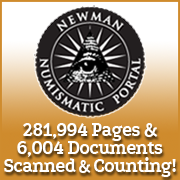
About UsThe Numismatic Bibliomania Society is a non-profit organization devoted to the study and enjoyment of numismatic literature. For more information please see our web site at coinbooks.org SubscriptionsThose wishing to become new E-Sylum subscribers (or wishing to Unsubscribe) can go to the following web page link MembershipThere is a membership application available on the web site Membership Application To join, print the application and return it with your check to the address printed on the application. Membership is only $20 to addresses in the U.S., $25 for First Class mail, and $30 elsewhere. For those without web access, write to: Terry White, Treasurer
AsylumFor Asylum mailing address changes and other membership questions, contact Terry at this email address: terrywhite5475@yahoo.com SubmissionsTo submit items for publication in The E-Sylum, just Reply to this message, or write to the Editor at this address: whomren@gmail.com BUY THE BOOK BEFORE THE COIN |
- WAYNE'S WORDS: THE E-SYLUM JULY 3, 2016
- SOTHEBY'S MILNE-HENDERSON SALE
- PLAIN TALK: PREDECESSOR TO THE NUMISMATIST
- BOOK PROJECT: MASSACHUSETTS TERCENTENARY MEDALS
- NEWMAN PORTAL INCORPORATES ROCHESTER MINUTES
- ARTICLE PROFILES ROCHESTER NUMISMATIC ASSOCIATION
- MORE ON ALUMINUM IN NUMISMATICS
- FOOD STAMP CHANGE TOKENS: A USER'S PERSPECTIVE
- NOTES FROM E-SYLUM READERS: JULY 3, 2016
- INAUGURAL MEDAL REPLICATED AS A BUTTON
- HISTORIC NEW ORLEANS COLLECTION MONEY EXHIBIT
- JOHN WARD DEAN (1815-1902)
- BUILDING THE LILLY COLLECTION, CONTINUED
- MORE ON CHESTER KRAUSE
- HARVEY STACK'S MEMORIES OF CHET KRAUSE
- SELECTIONS FROM DAVE WNUCK'S 'MAKING THE GRADE' #28
- SELECTIONS FROM 2016 HERITAGE SUMMER FUN SALE
- THE WILLMOTT-OGHIGIAN 1792 SILVER CENTER CENT
- ROSENBLUM SALE 46A CLOSES JULY 11, 2016
- SOTHEBY’S SELLS SET OF PICASSO’S SILVER PLATES
- SOTHEBY'S SELLS TROMPE L’OEIL BANKNOTE PAINTINGS
- BRITISH ARCHAEOLOGISTS ARE RUNNING OUT OF STORAGE
- TYRANTS COLLECTION ADDS 1344 EDWARD III DOUBLE LEOPARD
- RUSSIAN SILVER PATTERN FROM MOLDAVIA & WALLACHIA
- SOUTH VIET NAM 1000 DONG BANKNOTE OFFERED
- VIDEO: THE MAKING OF THE NEW FIVER
- NORTH KOREAN COUNTERFEITING REVISITED
- BELARUS CURRENCY REDENOMINATION
- FEATURED WEB SITE: WORLD'S FAIR AND EXPO MEDALS
Click here to access the complete archive
To comment or submit articles, reply to whomren@gmail.com
WAYNE'S WORDS: THE E-SYLUM JULY 3, 2016
New subscribers this week include: Andrew Cowen, Paul Sandler, Timothy Giambra and Chris Bower. Welcome aboard! We now have 1,989 subscribers.
My fellow Americans - Have a happy Fourth of July! This week we open with a numismatic literature sale announcement from Sotheby's London, two numismatic literature articles, and an update on the Newman Numismatic Portal.
Other topics this week include Food Stamp Change tokens, a New Orleans money exhibit, the Josiah Lilly collection, memories of Chet Krause, a 1792 silver center cent, Picasso's silver plates, North Korean counterfeiting, and World's Fair and Expo medals.
To learn more about Fulvio’s Illustrium Imagines, Plain Talk, the Massachusetts Bay Tercentenary, the Rochester Numismatic Association, Pittman's 1833 $5 gold piece, the Nagy plates, Lilly's "Hobby House", money art and Welfare Meat, read on. Have a great week, everyone!
Wayne Homren
Editor, The E-Sylum
SOTHEBY'S MILNE-HENDERSON SALE
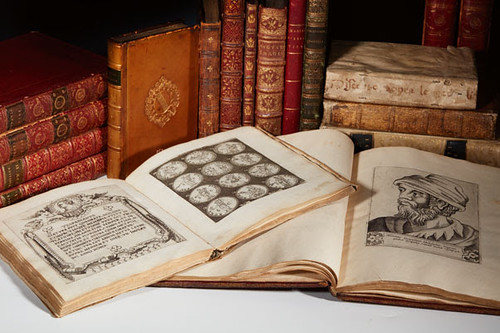
Sotheby's is delighted to announce that the timed online sale of The Patricia Milne-Henderson Collection: Books on Coins, Medals and Antiquities will take place from 8 to 18 July. This comprehensive and fascinating collection of numismatic books contains many rare and variant editions with wonderful illustrations.
The earliest book is Fulvio’s Illustrium Imagines of 1517, from where the collection stretches through the sixteenth century with numerous works by Du Choul, Goltzius, Huttich, Orsini, Strada and Vico. The later books include a unique copy of the Earl of Pembroke’s coin catalogue with manuscript documents about the collection bound in, and the Earl of Bute’s copy of Joseph Smith’s catalogue.
The provenances include Charles II, Andrew Fletcher of Saltoun, Sir William Stirling Maxwell, the Duke of Northumberland, the Earl of Pembroke and William Beckford, with fine bindings by Samuel Mearne and Kalthoeber, together with an early sixteenth-century Oxford binding with twelfth-century pastedowns. Association copies include a presentation copy signed by Abraham Ortelius and Francis Godwin’s copy of Agustín with his notes on Roman inscriptions he found in Caerleon in 1608-1609.
Registration for this sale will be available from 8 to 18 July.
Illustrium imagines
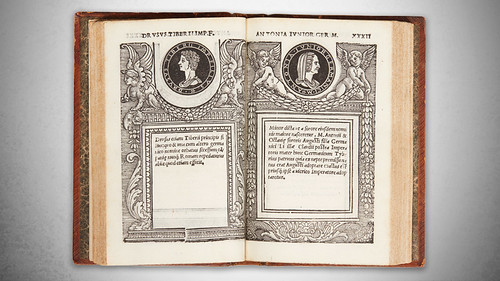
Andrea Fulvio (c.1470–1527), Illustrium imagines. Rome: Giacomo Mazzochi, 15 November 1517
This work is generally considered the first book to use medallion portraits of illustrious men and women in order to provide historical illustrations and moral exempla. Each page is designed to resemble an antique monument with the portrait above and the text (comprising a brief biography) carved beneath. The portraits are based on coins and medals in Mazzocchi's collection.
Illustrium philosophorum
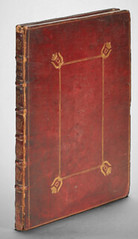 Girolamo Olgiati, Illustrium philosophorum, et sapientum effigies ab eorum numismatibus extractae. Venice, 1583
Girolamo Olgiati, Illustrium philosophorum, et sapientum effigies ab eorum numismatibus extractae. Venice, 1583
The elegant binding was made by Samuel Mearne and is consistent with the bindings he made for Charles II's library at St
James's; records show that he bound 830 books for St James's between 1663 and 1667.
Deorum dearumque capita ex vetustis numismatibus
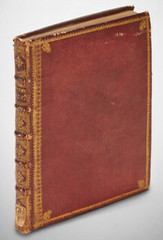 Abraham Ortelius Deorum dearumque capita ex vetustis numismatibus in gratiam antiquitatis studiosorum effigiata et edita. Antwerp:
Philippe Galle, 1573
Abraham Ortelius Deorum dearumque capita ex vetustis numismatibus in gratiam antiquitatis studiosorum effigiata et edita. Antwerp:
Philippe Galle, 1573
A book from the Earl of Pembroke's library at Wilton House; his books were mostly bound in this typical fashion, with the earl's
pencil notes to the binder specifying the covering material ("Turkey") and the wording for the lettering-piece.
Numismata antiqua
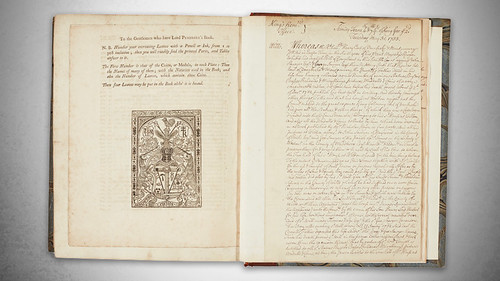
Thomas Herbert, Eighth Earl of Pembroke, Numismata antiqua. London, before 1746
This is a pre-publication copy which includes manuscript documents relating to the recently-deceased eighth earl of Pembroke including a note from the ninth earl acknowledging receipt of the "the collection of medals of sundry sorts & metals… in trust for the use of me and the succeeding Earls of Pembroke" dated 1733.
Coins of the Kings of Macedonia
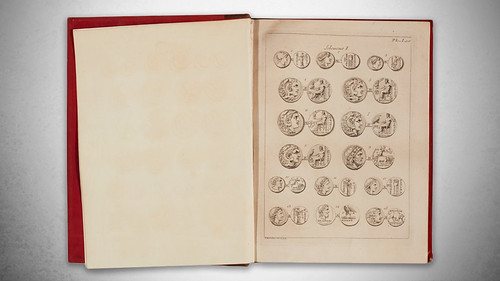
Duane, Coins of the Kings of Macedonia. London, 1798
The Beckford-Gennadius-Clements copy of Duane’s rare work on Macedonian coins with proof plates.
For more information on the sale, see:
The
Patricia Milne-Henderson Collection: Books on Coins, Medals and Antiquities
(www.sothebys.com/en/auctions/2016/online-patricia-milne-henderson-collection-books-coins-medals-antiquities-l16410.html)

PLAIN TALK: PREDECESSOR TO THE NUMISMATIST
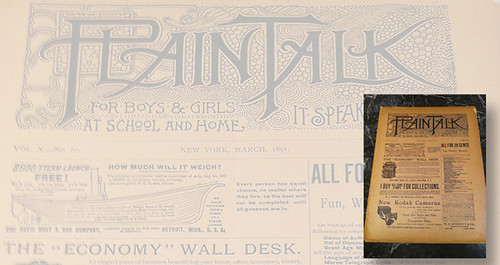
This month we focus on The Numismatist’s unofficial predecessor as the ANA’s official journal: the monthly newspaper Plain Talk, and its coin columnist, Charles T. Tatman.
Dr. George Heath started The Numismatist as a private publication in 1888. In his February 1891 issue, he advocated the creation of the ANA. In the July issue, he nominated a slate of officers. Heath also suggested that since his candidate for secretary, Tatman, was Plain Talk’s coin columnist, that paper should be the ANA’s “official organ.”
Heath’s gift as a politician rivaled his skill as a physician. His suggested officers haled from strategic regions of the United States and Canada. Tatman represented the East Coast, was a fine writer, and a rising star in numismatics. Since March 1891, he had conducted the “Coin Department” of Plain Talk, a New York-based, nationally distributed monthly newspaper for youth, with regular columns on several hobbies.
Tatman’s first Plain Talk column, for March 1891, echoed Heath’s question in February’s issue of The Numismatist: “Why should there not be an American Numismatic Association?” By May, with Heath’s blessing, he was prepared to lead the charge: “The American Numismatic Association! Collectors of coins are waking up to the fact that they need a national society. Let all who desire to band the body of collectors together with fraternal ties express themselves through Plain Talk.” July’s “Coin Department” announced welcome news: “It has now become a sure thing that an American Numismatic Association will be formed this year.” The next month, Tatman published the first ANA membership roster, with Heath member #1 and Tatman member #2. A total of 25 pioneers were listed, including combative dealer Ed Frossard, at #14.
Tatman’s September 1891 column announced that all ANA members (by then, 26), had voted for Dr. Heath’s slate of officers, so Tatman was the ANA’s secretary. No action was taken, however, on Heath’s suggestion that Plain Talk should become its journal. Tatman acted as if it was, issuing a detailed report in his November column on the first ANA convention, held in Chicago the month prior. This coverage continued into 1892, although with occasional errors. In The Numismatist for May 1892, Heath couldn’t resist asking “… Brother Tatman to please make our friend Frossard, Counterfeit Detector, instead of Counterfeit Director.”
In The Numismatist for June 1892, Heath announced that at the next convention, ANA members would be asked to formally choose an official organ; either “Plain Talk as at present” or The Numismatist. Heath’s next announcement, however, rendered this “choice” meaningless: “Secretary Tatman, owing to absence in Europe, has resigned as Secretary of the ANA…he will not be able to conduct the Numismatic Department in Plain Talk the coming year.” The Numismatist became official journal by default.
Tatman, as we shall see next month, returned to provide an important service to the ANA from 1893 to 1895, but thereafter, due to his busy law practice, he withdrew from numismatics. Assembling a complete set of Plain Talk during his time as coin columnist (March 1891 to May 1892) constitutes a major challenge for any dedicated numismatic bibliophile!
To read the complete article, see:
Would it be 'Plain
Talk' or 'The Numismatist'?: Finding a journal for the ANA
(www.coinworld.com/news/us-coins/2016/07/plain-talk-newspaper-almost-became-the-ana-journal.html)
BOOK PROJECT: MASSACHUSETTS TERCENTENARY MEDALS
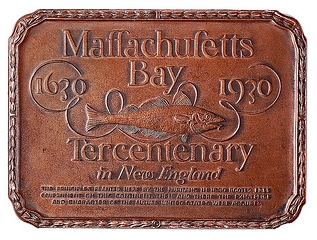 The NENA News arrived this week. It’s the official organ of the New England Numismatic Association. It contained three
announcements. First, the organization is planning a major celebration of its 75th anniversary to be held at their Conference and Convention in
November in Manchester, New Hampshire held in conjunction with the New Hampshire Coin and Currency Expo.
The NENA News arrived this week. It’s the official organ of the New England Numismatic Association. It contained three
announcements. First, the organization is planning a major celebration of its 75th anniversary to be held at their Conference and Convention in
November in Manchester, New Hampshire held in conjunction with the New Hampshire Coin and Currency Expo.
The second announcement was the banquet speaker which will be Q. David Bowers, prominent New England resident famed as a prodigious author – now approaching his 70th numismatic book – and as chairman of Stacks Bowers, noted for their auctions and offices on two continents.
But the third announcement was most notable for numismatic book lovers. Its members are gathering as many issues – and varieties – of the Massachusetts Tercentenary of 1930. The standard work on the subject was compiled by Shepard Pond and published in 1931 the same year NENA was founded.
How appropriate to update this publication for the organization to document all issues known and new to celebrate this dual anniversary this year.
Collectors with Massachusetts Tercentennial medals are urged to contact the coordinator for the project at massterc1930@verizon.net If you can send a photo or scan, fine. Admirable project.
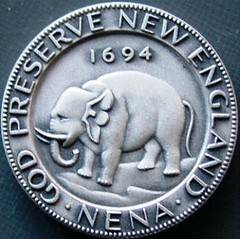
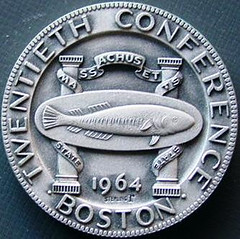
For more information about NENA, see:
http://www.nenacoin.org/
THE BOOK BAZARRE
NEWMAN PORTAL INCORPORATES ROCHESTER MINUTES
Rochester Numismatic Association Minutes
One of the oldest member clubs of the American Numismatic Association (ANA), the Rochester Numismatic Association (RNA) was formed in January 1912 by Dr. George P. French with 32 charter members. RNA has hosted three ANA conventions, in 1912, 1917, and 1928.
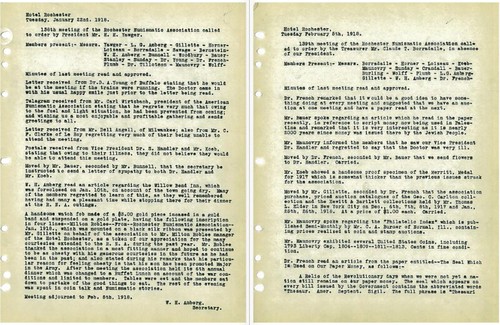
Link to the Rochester Numismatic Association Minutes:
https://nnp.wustl.edu/library/archivedetail/510663
ARTICLE PROFILES ROCHESTER NUMISMATIC ASSOCIATION
The 2,198th meeting of the Rochester Numismatic Association began last week with a joke, actually two jokes.
A numismatic association is an organization for coin collectors, so it’s not surprising that one of the howlers cheerfully told by RNA President Gerald Vaccarella of Brighton turned upon a coin-related pun.
Fifty or so collectors at the meeting groaned when Vaccarella threw out the punch line, something about a skunk spending his last scent. Get it?
And thus the meeting in the basement of the Rochester Museum & Science Center’s Eisenhart Auditorium was off and running, continuing a coin conversation that began in January 1912 when the club was founded.
Think of that. The RNA, the second oldest numismatic association in the United States (the oldest is in Chicago), has continued to hold meetings for more than 100 years. How can this be?
“The cross-section of people here is phenomenal,” says Susie Scoppa of Fairport, an RNA member. “It really is an interesting place to be. And who isn’t interested in money?”
Scoppa has just retired from teaching Latin at Irondequoit High School, where she used ancient Roman coins to help her students learn the language. It was fun; it was real; it worked.
Every coin, it seems, has a story to tell.
“Give me a dollar,” says Donovan Shilling of Penfield, a prolific writer on Rochester history and a member of the RNA.
I hand him a wrinkled bill. He hands me a shiny 2016 Sacagawea dollar coin. He tells me to look at the reverse side honoring the Native American code talkers who transmitted secret messages in World War I and World War II.
Every year now, Shilling says, the Sacagewea coins feature the contributions of different Native Americans.
He clearly admires these coins, but he also likes coins that have images of ships. He dwelt upon this fascination at an earlier meeting of the association this year in a talk titled “Coins and Medals Rekindle the Romance of the Sea.”
Everyone in the association collects, but as good as their collections are, they cannot rival that of the late John Jay Pittman, a numismatic superstar who put Rochester coin collecting on the map.
Pittman’s life story is made-for-TV ready. Born into poverty in North Carolina (he was 10 years old before he got his first new pair of shoes), he worked his way through college, became a chemical engineer at the Eastman Kodak Co. and quietly, shrewdly collected coins.
Most famously, Pittman took out a second mortgage on his home in Greece in 1954, traveled to Egypt with cash and purchased at auction some of the coins in what had been King Farouk’s collection. He bought one of those coins, an 1833 $5 gold piece, for $605. It later sold for $467,500. After he died, Pittman’s collection sold for $30 million. Yes, $30 million.
Pittman served a term as president of the RNA. He also was president of the American Numismatic Association and president of the Canadian Numismatic Society.
He spent a great deal of time spreading the gospel of numismatics, telling groups large and small that coin collecting can be educational, fun and rewarding. That message is repeated again and again at the meetings of the Rochester Numismatic Association.
“It’s an easy hobby,” says RNA member Maria Paris of Rochester, who especially encourages women to join as the group tilts male. “(Coins) are small, transferable and very aesthetic.”
Which is why at 2,198 meetings and counting, the group is going strong. Which isn’t surprising. After all, who isn’t interested in money?
To read the complete article, see:
Jim Memmott: They’ve been showing the money since 1912 (www.democratandchronicle.com/story/news/local/columnists/
memmott/2016/06/28/jim-memmott-theyve-been-showing-money-since-1912/86473168/)
To read the earlier E-Sylum articles, see:
NEW BOOK: ROCHESTER NUMISMATIC ASSOCIATION CENTENNIAL HISTORY
(www.coinbooks.org/esylum_v15n05a05.html)
FEATURED WEB SITE: ROCHESTER NUMISMATIC ASSOCIATION
(www.coinbooks.org/esylum_v15n05a28.html)
MORE ON THE ROCHESTER NUMISMATIC ASSOCIATION
(www.coinbooks.org/esylum_v15n06a06.html)

MORE ON ALUMINUM IN NUMISMATICS
Early Dated Aluminum Tokens and Medals
Most collectors of tokens issued during the 1876 Centennial are familiar with the attractive 39mm issues of Stiner Tea Company of New York City. While normally encountered in brass, copper, or white metal, an example in aluminum, with the Independence Hall 1876-dated reverse, is known to exist, as is a specimen struck in leather. We must assume that these extremely rare tokens were made for some special purpose, or possibly to the order of a collector at a later date.
Stranger yet is a token advertising W. A. Bunting & Son of Pittsburgh, Pennsylvania. This firm, which manufactured stencils, steel and rubber stamps, seals, etc., very likely also struck tokens and medals. Their piece, which is struck in aluminum, depicts the Trademen's Industrial Institute on its reverse and is dated 1876. Some collectors point to it as the earliest aluminum token.
Although I can't state that the token was, without question, manufactured sometime after the 1876 date would suggest, another W. A. Bunting & Son piece in my collection was struck with the same obverse die. Its reverse pictures the battleship Maine, with the inscription REMEMBER THE MAINE / DESTROYED / FEB. 15, 1898. My theory is that both tokens were struck in the late 1890s. This assumption is strengthened by the existence of yet another Bunting token, struck in white metal or lead, with the same "Trademen's Industrial Institute" reverse die. Its obverse differs in that the firm's name is given as W. A. Bunting; evidently in 1876 "& Son" was not part of the company name.
Benjamin P. Wright, in his American Business Tokens (originally published between 1898 and 1901 in various issues of The Numismatist), lists as number 1665 an intriguing aluminum piece. Its obverse depicts "The Educator" (Dr. William L. Johnson, according to Wright), while the reverse depicts an all-seeing eye on a bar, within three circles; around this is the legend SINCERELY THINE TO BLESS and the date, 1885. If the fact that I own two specimens is any indicator, the piece is not especially rare.
While Wright provides us with the meaning of the all-seeing eye, etc., he ignores the oddest feature of the token -- its 1885 date. It seems unlikely that the piece was struck during that year, a time when the cost of aluminum was eight dollars a pound. As mentioned earlier, Charles Hall didn't graduate from college until 1885, and the first aluminum was not produced by his process until the following year.
Pre-Columbian Exposition Aluminum Tokens and Medals
In 1888 aluminum was still a relatively expensive metal to produce. However, aluminum medals were struck during that year. For example, the Schwaab Stamp & Seal Company of Milwaukee, Wisconsin produced an attractive piece for the 25th North American Saengerfest, held in St. Louis, Missouri during June, 1888. Issued as "a souvenir of the Cream City," the 38mm medal depicts a panoramic view of Milwaukee Bay, with the city in the background.
By the following year the manufacture of exonumia in aluminum was no longer a rare occurrence. The 1889 centennial of George Washington's inauguration was occasion for the issuance of many commemorative medals, and the well known Chicago die sinking firm, S. D. Childs and Company, seized the opportunity to strike pieces in the "new metal." One of these has, on its obverse, a bust of Washington facing left with the inscription WASHINGTON CENTENNIAL. The reverse legend of the 37mm piece extols the qualities of aluminum as MALLEABLE, / TASTELESS, SONOROUS, / DUCTILE, / UNTARNISHABLE. / ALUMINUM / CUBIC FOOT OF GOLD, 1204 LBS. / " " ALUMINUM, 179 " / THIS MEDAL / IS PURE.
Having cut this reverse die, Childs, a practical businessman, offered it to other prospective customers for aluminum medals. It is found on the reverse of a souvenir piece issued for the state of Nebraska's silver anniversary in 1892, and on a medal for the Mitchell, South Dakota, Corn Belt Exposition held that same year. A medal for the 1892-3 Columbian Exposition was also struck with the die, as were various other pieces issued during the early 1890s.
To read the earlier E-Sylum article, see:
EARLY USES OF ALUMINUM AS A COMMON METAL
(www.coinbooks.org/esylum_v19n26a24.html)

FOOD STAMP CHANGE TOKENS: A USER'S PERSPECTIVE
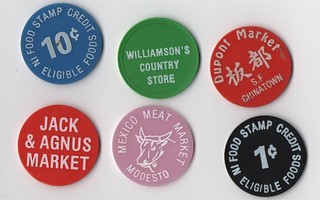 I have wondered for years about what happened when the expensive old system of "change tokens" was used to deny actual money
change in US coins to be issued, instead of otherwise useless plastic or paper receipts. I remember the plastic chips in Brooklyn stores and the
paper slips (actually purchase receipts) from larger stores which had the amount of change printed on them, in Boston. Those were the days before
'77-8 when you had to BUY your food stamps.
I have wondered for years about what happened when the expensive old system of "change tokens" was used to deny actual money
change in US coins to be issued, instead of otherwise useless plastic or paper receipts. I remember the plastic chips in Brooklyn stores and the
paper slips (actually purchase receipts) from larger stores which had the amount of change printed on them, in Boston. Those were the days before
'77-8 when you had to BUY your food stamps.
Many-perhaps most Americans know so little about this program that they are unaware that it was run by the USDA and that monthly, a purchase order was mailed to participants which had used a mathematical formula to decide both how many stamps a person could buy and how much they had to pay for them.
Obviously, the system charged less than face value or no one would have bought them.-But not really much less-many stamp users had to pay 65C per dollar for stamps. Others only paid 30 cents on the dollar. It depended on the formula.
In fact, so onerous and so expensive was the buying of the actual stamp booklets, that as many as half of most single persons (the highest payers in cash for stamps), often just sold their orders for extra "cash money" in actual dollars and cents.
So miserly was the system, an order to purchase "$50" worth of USDA coupons which could be used ONLY to buy food items, not tobacco, not liquor, nor beer and often, many stores were so mean spirited that they tried refusing to sell items to stamp users on personal political grounds. What many of these middle level managers were not aware of was that each store owner who accepted USDA stamps was paid, in addition to their face value in real US money, another 10% . This means that buying anything with food stamps was paying 110 cents on the dollar for every purchase!!!
This was a bonanza for any concern selling food stamps. They earned 1.10 cents for redeeming 1 dollar in stamps. The sellers of the stamps, if they bought the order for cash, received the difference between how much they paid and the full face value plus 10%, for the few dollars they paid for it. It was an all American hustle with druggists, bankers and all sorts of people getting into the business.
THIS MEANT THAT HAVING TO GIVE USERS CRUMMY BUT EXPENSIVELY MADE PLASTIC, PAPER OR ALUMINUM TOKENS IN CHANGE COST ALMOST AS MUCH OR MORE THAN JUST GIVING OUT REAL CHANGE! Although, for any transaction, less than 99 cents in fake money change was given to anyone regardless if the purchase was 1 dollar or 100 dollars.
The reasoning behind the use of tokens as change was that before the era of inflation of the 1980's, food stamp money could buy a lot of stuff most Americans were used to eating. The fear or excuse was that stamp users would take any and all cash change and buy tobacco, liquor or drugs. Ohhhh! For shame!
In fact, every time some Senator voted to hang another sign on stamp users that read "I am a poor person who must be punished", the stamp users would often, to avoid losing purchasing power of REAL money, sell their stamps.
Food stamps, being worth 10% more than dollars, sold for between 70 and 85% of face value. All of this was the fault of turning the recipients into poverty-stricken second class citizens who hated to use the funny money because of the stares and angry comments they often heard from other purchasers.
This pretty much ended as, as many as a fifth or 20% of Americans had to use food stamps at one time or another. The issuance of cards has made the system almost invisible as now it is hard to tell a food stamp card (EB FT card). from a credit card.
As a college student I qualified for stamps for a couple of years before Reagan. I always wanted to save a complete 10 dollar or 20 dollar "book". Stamps came in books, each one of which had a predetermined value, but I never had the ability to "waste" so much purchasing power. As a result, I have about 2 cents worth of Grand Union aluminum pennies.
Unlike the change tokens, the actual food stamps were carefully and handsomely printed with a an easy to sense texture on one side. and their value and serial numbers clearly printed in black ink. The different stamp amounts were $1, $5, $10 and $20, as I recall.
I am surprised to find anyone else who is interested in the era as it seemed non-existent on the internet before 2015. Go for it! I always wondered who made those colorful plastic "chips."
Few people know that Food Stamps originated back in the FDR, depression era administrations. Stamps were not as common, once -the USDA gave out canned and prepared foods. One of which was the (I thought) quite tasty "Welfare Meat", a canned meat made of whatever meats were available to the USDA or canneries and meat processors working for the USDA and placed in cans without much information other than "Meat".
Some people thought it had the consistency of a heavy dog food, but it tasted better. This was a delicacy I tried in 1967-it appears NYC ceased handling it as it was heavy and thus expensive to move. It stored for decades and much may have been from USDA war reserve stock (in event of a World War Three type event or floods and storms, the big US agencies kept such food stuff in huge refrigerated caves or other old aircraft hangers).
To read the USDA's History of the program, see:
Supplemental Nutrition Assistance Program (SNAP)
(www.fns.usda.gov/snap/short-history-snap)
To read the earlier E-Sylum articles, see:
MORE ON FOOD STAMP CHANGE TOKENS (www.coinbooks.org/esylum_v18n12a23.html)
THE HISTORY OF FOOD STAMP CHANGE TOKENS
(www.coinbooks.org/esylum_v18n05a11.html)
THE BOOK BAZARRE
NOTES FROM E-SYLUM READERS: JULY 3, 2016
The Nagy New Jersey Copper Plates
Ray Williams writes:
Among NJ Copper collectors there exist photographic plates that we call Nagy Plates. These are credited to the same Stephen Nagy that John Lupia posted the biography for in the last issue of The E-Sylum. Other than these plates, I don't know of anything else he had done for colonial numismatics.
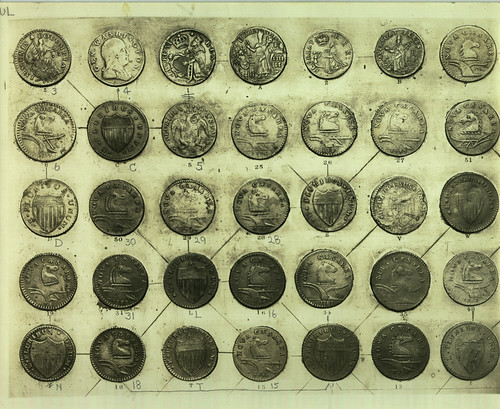
To read about the Maris plates, see:
http://www.coins.nd.edu/ColCoin/ColCoinContents/DieCharts.html#NJdies
To read the earlier E-Sylum article, see:
STEPHEN KENNETH NAGY, JR., (1884-1958)
(www.coinbooks.org/esylum_v19n26a15.html)
American Political Items Collectors Convention
Alan V. Weinberg writes:
I'm flying to Harrisburg PA on Tues-Sun for the biannual national APIC (American Political Items Collectors) convention which is 100x more rewarding and interesting than many other shows...with bourse tables less than 10% of what they cost at the ANA and considerable room hopping activity before the bourse.
You'll see and can buy more small historical collectibles than you ever imagined existed for a tiny fraction of what you'd pay for an equally rare coin or currency item. This field was popular amongst numismatists back to the 1860's, according to early coin auction catalogues. Sadly, more and more of this stuff is being slabbed now by numismatic dealers seeking to expand their offerings and engage collectors priced out of the rare coin market.
To visit the APIC web site, see:
www.apic.us
ROSENBLUM AUCTION
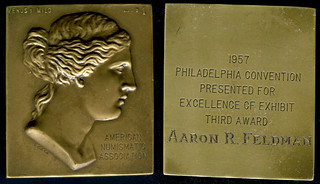
Lot 267: 1957 ANA Exhibit Award to Aaron Feldman
Our Summer 2016 auction 46A featuring the "Philadelphia Collection" Part Three is now online, with a closing date of July 11, 2016. Please click on the link to the auction here.
INAUGURAL MEDAL REPLICATED AS A BUTTON
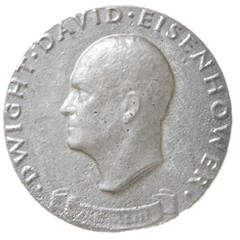
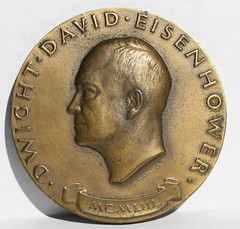
1953 Dwight Eisenhower Inaugural medal
Left: Cast Copy Button; Right: Original Medal
Recently Good Wife and I attended a button show. My interest was to learn some technology of how buttons were made since certain button making technology is so similar to coin making. Often the best button makers of 19th century in Europe became coin or token makers. I loved chatting with dealers who often have special knowledge.
At one table while I was examining a card of Scovill buttons, wife Shirley picked up a gray metal button somewhat larger than most on display. “It looks like a medal” she said. as she handed it to me. Indeed it did. It was the obverse of the Dwight Eisenhower Inaugural medal of 1953. It had a loop shank embedded in the middle of a flat back to make it a button.
“What’s the story on this one, it’s cast?” I asked the dealer. He explained it was made by J.F Eutzy of Pennsylvania; his logo is on the back. He only made thirteen by sand casting and gave them to members of his wife’s button club.
At home I examined the item more closely. The original was by Paul Manship and struck by Medallic Art Company. The artist’s name had been removed on this copy and the lettering in the Roman numeral date were indistinct. The spruce mark was at the top edge. It was trimmed on a lathe for a smooth uniform edge. Research identified the caster: Joseph Frederick Eutzy (1902-1970) of Lewisberry, Pennsylvania.
While the replication of such an important medal is not a criminal act, it is nearly so. The medal was copyrighted just to prevent such desecration. The pebbly cast surface and the poor quality of the item was in distinct contrast to the sharp image and smooth surface on the original struck medal. It was an insult to the artist, Paul Manship, to President Eisenhower and to the Inaugural Committee which authorized it.
Even though Medallic Art’s name was not on the cast button it reflects badly on the firm, which goes to the extreme to produce medallic art of the highest quality. For that reason the firm obtains copyright protection for all important medals; The Society of Medallists and Hall of Fame series are just two in which every medal was copyrighted.
Actually the copyright must be in the artist’s name and then assigned to Medallic Art. This is necessary for the inherent longevity of the firm, in contrast, say, to an Inaugural Committee which goes out of existence shortly after the Inaugural is over.
No action can be taken in this case since the person who made it is dead. Unfortunately there are twelve more of these buttons still in collectors’ hands.
HISTORIC NEW ORLEANS COLLECTION MONEY EXHIBIT
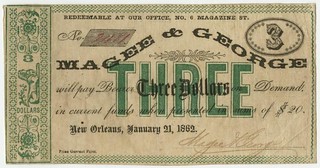 Money can reveal a wealth of information about the culture that used it. Coins and bills serve as small, colorful windows into the past,
making history every time they are exchanged as legal tender. Changes in currency reflect social change, as demonstrated by the United States’ recent
decision to boot Andrew Jackson from the $20 bill in favor of abolitionist Harriet Tubman.
Money can reveal a wealth of information about the culture that used it. Coins and bills serve as small, colorful windows into the past,
making history every time they are exchanged as legal tender. Changes in currency reflect social change, as demonstrated by the United States’ recent
decision to boot Andrew Jackson from the $20 bill in favor of abolitionist Harriet Tubman.
The Historic New Orleans Collection has more than 200 old notes and coins on display for its “Money! Money! Money!” exhibit in the Williams Research Center at 410 Chartres St. The free exhibit, running through Oct. 29, includes an interactive bingo-style dollar hunt. And, a staff member is available to help inquisitive visitors navigate the impressive collection.
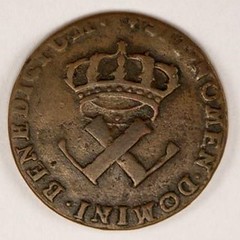 “The purpose of this show was for us to better understand a collecting category that we’ve had since the 1950s, which has grown
exponentially throughout the years, but that hasn’t had a dedicated curator,” Greenwald said.
“The purpose of this show was for us to better understand a collecting category that we’ve had since the 1950s, which has grown
exponentially throughout the years, but that hasn’t had a dedicated curator,” Greenwald said.
Elaborate banknotes from the antebellum period make up much of the collection, Greenwald said. There was a boom in new currency as new cities were settled on the Western frontier.
The diversity among bills in circulation also made counterfeiting easier, as people were more likely to mistake an unfamiliar banknote forgery from a far away city. Counterfeit detecting handbooks were used by cashiers to assist with the identification of fakes, but of course, these manuals also helped counterfeiters perfect their forgeries.
The imagery on the bills, selected by bank officers, changed often in an attempt to outpace counterfeiters. The depictions chosen provide insight into the culture that produced them.
Bills often would feature scenes of commerce and local culture. New Orleans banknotes, for example, showed images of ports, rivers and boats. When the Confederate States of America began printing currency, the notes promoted Confederate ideology with references to the domestic slave trade.
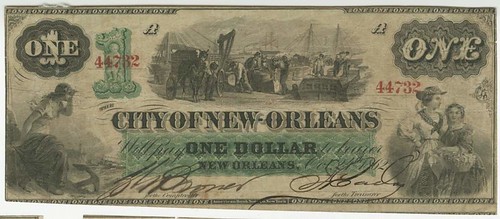
Currency remained decentralized throughout the Civil War and up until the passage of the National Banking Acts of 1863 and 1864, which gave the federal government jurisdiction over banking. These acts prohibited nonfederal banks from issuing coins and taxed them for issuing banknotes.
“Money! Money! Money!” concludes its presentation of early U.S. banking with some of the first federal banknotes, the predecessors of modern U.S. dollar bills. The arrival of these “demand notes” heralded the end of state and local currencies, which were discontinued in response to the new tax.
For more information on the exhibit, see:
http://www.hnoc.org/moneymoneymoney/
THE BOOK BAZARRE
JOHN WARD DEAN (1815-1902)
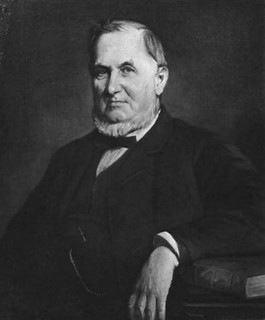 John Ward Dean (1815-1902), was born in Wiscasset, Lincoln County, Maine, on March 13, 1815, the fifth of six children, son of Charles
(-1829)and Patience Tappan Dean.
John Ward Dean (1815-1902), was born in Wiscasset, Lincoln County, Maine, on March 13, 1815, the fifth of six children, son of Charles
(-1829)and Patience Tappan Dean.
Dean is a noted American antiquarian, scholar, writer, editor and publisher with a myriad of associations with noted numismatists, especially his close friend and colleague Jeremiah Colburn (1815-1891), and the New England Historical Genealogical Society, Boston Numismatic Society, and the Numismatic and Antiquarian Society of Philadelphia of which he was a corresponding member, and was the first editor for Boston of The Historical Magazine and Notes and Queries published at Boston by Dean's friend and colleague Charles Benjamin Richardson (1832-1891). Dean was an Early American historian and scholar and expert on American Colonial Numismatics.
He graduated the Latin School at Mt. Vernon, Maine, which recently had been incorporated in 1792 a little over three decades previous. He then graduated from the English High School, Portland, Maine (which Ebenezer Locke Mason, Jr. also graduated a decade after Dean).
In January 1857 he began as editor of The Historical Magazine and Notes and Queries, that published many numismatic articles in the interest of numismatic history and collecting and served as the organ for the Boston Numismatic Society, the Rhode Island Numismatic Association, the American Numismatic Society, and the Numismatic and Antiquarian Society of Philadelphia, and the American Antiquarian Society. Dean and Colburn were responsible for publishing the Boston Numismatic Society meeting reports.
In 1872 he retired from Dean & Co. and became the full-time Librarian of the New England Historical Genealogical Society. He resigned in 1889 when he became the editor of the New England Historical Genealogical Register. He returned as Librarian in 1892 until his death on January 22, 1902.
The significance and value of the biographical research Dean had undertaken is summed up in the final address given in 1862 by the then stepping down president of the New England Historical Genealogical Society, and noted numismatist, Dr. Winslow Lewis :
"The union of Genealogy with Biography, Heraldry, Numismatics and History was set forth and exemplified fully; but there was a province of Genealogy of peculiar importance, which has seldom been brought before the notice of our Society; and coming from one of eminent professional experience it has the sanction, as it were, of a truth ex cathedra. It is this: "That mental as well as physical qualities are handed down more or less from parent to child, from forefathers to posterity, and that thus, pure and healthy descent is of immense importance. * * * And very frequently we can ascribe the united qualities of valor and of virtue, of great intellect and gentle heart, to the marriage union of parents, whose families were respectively distinguished for these virtues."
His portrait was painted in 1888 by James Harvey Young and is now in the collection of the New England Historical Genealogical Society. A photogravure of the painting was produced by Elson was made after his death.
In 1893 he wrote and published Memoir of Jeremiah Colburn, A.M. portraying him a la sentiment of notions we have just read presented by Dr. Lewis just over thirty years previous.
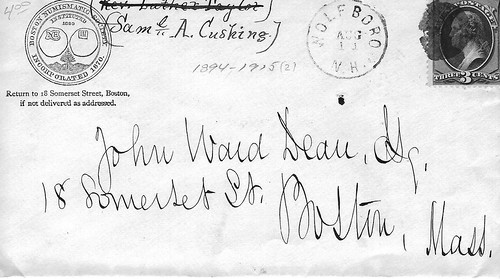
To read the complete article, see:
DEAN, JOHN WARD
(https://sites.google.com/a/numismaticmall.com/www/numismaticmall-com/dean-john-ward)

BUILDING THE LILLY COLLECTION, CONTINUED
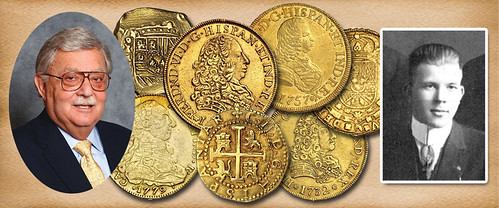
The Hobby House at Eagle's Nest
In the spring of 1952 Mr. Lilly visited Stack’s to review what we had shown him earlier and to examine other coins we had assembled for
him. He also discussed naval history and the explorations made by nations other than Spain in the 15th to 19th centuries. He was fascinated
by the story that was developing as the ships traveled west across the Atlantic. He asked what kind of coinage did countries like England,
France, Portugal and Italy make from the gold they assembled trading between Europe and the Americas.
We showed him examples from each country, as Stack's always maintained a good representation of world coins on hand, and he examined them and said he would be in touch to let us know how he wished to proceed.
Late in May of 1952 he contacted us and asked if we could hand deliver what we had already acquired for him and bring along the group of English and French coins we had shown him. Since the shipment was quite valuable I accompanied my father, Morton, on the trip to make the delivery.
Mr. Lilly's secretary called, suggested the flight we should take, made reservations for us at the Indianapolis Athletic Club, made dinner reservations for us, and advised that Mr. Lilly’s driver would pick us up the following morning at 8:30 AM and take us to see Mr. Lilly. She also arranged for a late afternoon flight back to New York.
Like clockwork we were met in the Club's lobby, were escorted to a Rolls Royce and were taken to see Mr. Lilly. We knew that he lived with his wife in a residential park-like area in downtown Indianapolis, which bore the name "Oldsfield." However, we noticed that we were being driven out of town. The chauffeur explained that Mr. Lilly had a personal retreat on the outskirts of Indianapolis and we would meet with him there.
As we drove, we saw a large forest and the driver announced that we were about to enter the 5,000-acre forest preserve in which Mr. Lilly built his retreat -- "Eagle’s Nest.” It was beautiful, with stately trees and well kept grounds. A few miles into the forest we came to buildings made of natural Indiana stone in a clearing within the forest. -- the site of Eagle’s Nest. One large building, we were told was the Guest House, used by family and friends who stayed on the location for lengthy periods of time. The other immense building was Mr. Lilly’s retreat, magnificently designed, and with several giant matching pine trees near the driveway to that building.
Mr. Lilly greeted us at the door, welcomed us to "Hobby House" at Eagle's Nest, and gave us a brief, instructive tour. He talked of his hobbies, which now included collecting gold coins, Revolutionary Rifles and other armament, stamps, seascape paintings, (some he painted himself), uncut diamonds and rare colored stones. He was also very proud of his library, located in a separate wing and containing many of the rarest volumes of English and American literature in private hands, together with maps and manuscripts, from Shakespeare to the early 20th century. He had a magnificent collection of lead toy soldiers, some 5,000 pieces, in cases about his large display rooms.
Josiah K Lilly was a dedicated collector, who enjoyed his hobbies and devoted time to studying about them. Now we became part of this collector's love of collecting, as we delivered the gold coins we had found for him, and worked with him to arrange them in the many trays we had ordered to house his “new hobby."
In the next part of this story I will tell more about our visit and the role Stack’s continued to play in developing this important gold coin collection.
On to U.S. Gold
On his visit in the spring of 1953 we were able to show him what we had assembled. With the addition of this group his collection of
doubloons would be close to 200 different pieces. He liked what we had done, and asked that we bring them to Indianapolis within a few
weeks, which of course we did.
He then expressed interest in another collecting area: the gold coins of the United States. We explained that we had built collections for many others. He learned that in 1943 Stack’s had bought all the half eagles, ($5 gold) 1795 to 1929, and eagles ($10 gold) 1795 to 1933, from the Col. E.H.R. Green Collection. Included were hundreds of duplicates, especially in the early issues, before the coin sizes were reduced.
The first sets of $5 and $10 gold we sold to King Farouk of Egypt, through his personal representative. These were sent by diplomatic pouch to Cairo. The second set, almost as complete as the first, we sold to an American client, Clifford T . Weihman. The balance of the dates and duplicates were put into our inventory. Even after we sold the two sets, it was still the largest stock of early coinage in any dealer’s inventory. We showed Mr. Lilly examples and he said he would think about it.
As he had started collecting with the largest gold Spanish-American coins, he felt he should start with the largest coin of the United States, the $20 gold double eagle. Mr. Lilly asked, "How many different are there?" We told him there were 199. He replied that it would take some time to assemble that many pieces. We told him about a collector in Texas who might consider selling his set of $20 gold coins. He expressed his interest and suggested we inquire about it and if possible let him know on his return to New York in the fall. After he left for Indianapolis we started our pursuit of double eagles.
In early May I again traveled with my father, Morton, to Indianapolis, following the established system and delivered what we had acquired over the previous winter.
Soldiers
At Eagle’s Nest, Mr. Lilly showed us again his growing collection of lead soldiers. Each group had five to seven soldiers lined up, showing
the foot soldier, the flag bearer, the drummer, the officer in charge, and sometimes the general. Each was accurately fashioned into the
proper uniform of that division, each with the appropriate hat, the proper sashes and epaulets in place, the correct color for a dress
parade. He had over 4,500 soldiers, ranging from the Green Mountain Boys, to Colonial soldiers, to post-Revolution federal troops, through
the decades before the Civil War. There were examples wearing the various uniforms of the Blue and the Grey and (which were often different
as each regiment had its own designs and hats, yet basically in the colors of the North or South) continuing to the First World War. It was
a view of history, in miniature.
These lead soldiers were amazing when you saw them all displayed before you. Mr. Lilly had employed the finest maker of lead soldiers, who resided in Philadelphia to make and complete his collection. Dedicated collector that he was, Mr. Lilly personally researched the appropriate uniforms for each regiment he portrayed. As with all his hobbies, he researched them carefully, and engaged only qualified experts to guide him.
To read the complete articles, see:
Building a World Class Numismatic Gold Coin Collection: The
Josiah K. Lilly Collection Part 4 (www.stacksbowers.com/News/Pages/Blogs.aspx?ArticleID=2128)
Building a World Class Numismatic Gold Coin Collection: The
Josiah K. Lilly Collection Part 5 (www.stacksbowers.com/News/Pages/Blogs.aspx?ArticleID=2150)
To read the earlier E-Sylum article, see:
BUILDING THE JOSIAH K. LILLY COLLECTION
(www.coinbooks.org/esylum_v19n23a15.html)
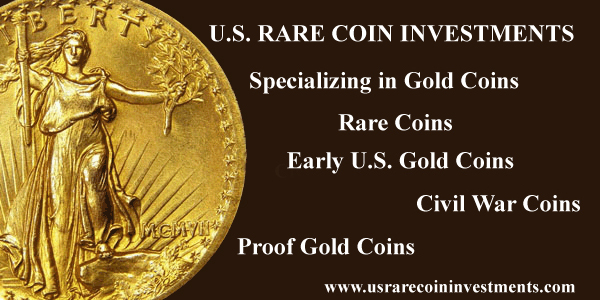
MORE ON CHESTER KRAUSE
Chet's Last Days
Clifford Mishler writes:
He died peacefully shortly after 9:30 Saturday evening. He had been living in his apartment at the local Living Oaks facility, attended to by hospice type folks up to this past Tuesday, when he was transferred to the local rest home facility. Two of his nieces were by his side when he passed; I received an advisory call from them shortly thereafter. I had last spoken to him on Friday.
He had actually been doing quite well until about 8 to 10 weeks ago; at that time I was thinking he had a good chance of making it to his 93rd birthday this coming December. About three weeks ago, however, his physical health started falling rather rapidly and consistently. Two weeks ago today was the last time he made it in to his office for what had long generally been almost daily visits; his office was just two doors from mine in a commercial condominium that we shared with others in downtown Iola.
Books on Krause Publishing History
David Gladfelter writes:
There are two earlier books about Chet and his publishing business, Just Plain Chet: The History of Krause Publications by Michael J. Goc (1992), a chronological account, and Pioneer Publisher: The story of Krause Publications' first 50 years by Arlyn G. Sieber (2001). The latter book has an appendix listing all the books and magazines published by Krause, the coin and hobby shows it sponsored, and a list of the names of all Krause employees through July 1, 2001.
When Sieber's book came out, free copies were given to persons who attended presentations given by Krause employees at shows. And not to be overlooked is Krause's establishment and sponsorship of the Numismatic Ambassador program in 1974. They published a list, with photos, of all the winners in 2003 (I see your mug in there, Wayne, class of 2002). Closest thing American numismatics has to a Who's Who, I would say.
Redbook Editor Kenneth Bressett
Ken Bressett writes:
I knew, respected and admired Chet for all he did to spread the word about the joy of coin collecting. He was truly a giant in the hobby.
John and Nancy Wilson
John and Nancy Wilson write:
On June 25, 2016 we all lost a good friend and a great numismatist Chester L. Krause, who was born on December 16, 1923. Besides being a World War ll veteran and builder, a man called "Chet," was a numismatic icon who spoke in a mild and knowledgeable manner. You could say he carried a big stick with his excellent actions and communications and helped advance our numismatic hobby in countless manners.
Starting in the early 1950s, KPs weekly publication Numismatic News was a powerful source of information for collectors from coast to coast. From that beginning and over the years other periodical publications were started such as Bank Note Reporter, World Coin News and Coins Magazine. These don't include the many hobby publications that are also under the Krause Publications and F + W umbrella, with many being standard references today. We found out on their web page over 150 different publications are part of the Krause Publications and F + W brand.
The firm continues to be a leader in numismatic and hobby publications along with a diverse selection of coin supplies. Today, Krause Publications in Iola operates with a very small staff and continues to print excellent periodicals and other publications in a timely and efficient manner. Chet started an Employee Stock Ownership Plan (ESOP) in 1988. The ESOP ended not long after F + W took ownership of the company in 1992 when the shares were distributed mostly to the employees.
Besides Mr. Krause's great impact in the numismatic hobby with his periodicals and publications, he was a great advocate and benefactor for our hobby and his beloved Iola, Wisconsin. His donations in the numismatic hobby were great. Over the years he was honored with the highest awards by many different organizations such as the ANA, ANS, CSNS and others. After making a significant donation to ANA, Chet and Cliff were instrumental in getting the ANA Museum named the Edward C. Rochette Museum in 2005. To find a new direction for the Association, Chet served on the ANA board twice, starting in 2007 and resigning in 2010.
He was also a phenomenal collector and researcher of not only his State of Wisconsin, but also of all types of Depression Scrip, World Bank Notes, Postage Currency Envelopes, Canadian Coins (including a rare Canadian 1936 Dot Cent) and many others. His great collections were sold by several major auction firms. His automobile and military collections were also fantastic, and over the years were sold. We know he wanted to get back the Sherman tank he sold and keep it in Iola.
The Iola Car Show (started in 1972) held annually is on land that once was owned by Chet Krause and nearby to the Krause Publications headquarters. The Iola Car Show site recognized Chet after his passing and said, "Chet’s influence in this area is felt far beyond what words can express, and we could never repay all he’s done for us and our community.
Chet's contributions to Iola are legendary and run into millions of dollars and countless hours dedicated to the city he loved. Besides Iola, Chet was a major benefactor to Rawhide Boy's Ranch in New London, WI. Chet's obituary states that any donations made in his memory go to Rawhide (www.rawhide.org).
He also made donations to several Wisconsin based companies, and in 1990 was named the state's Small Business Person of the Year. His philanthropy in many areas was huge, and he never wanted any thanks or a pat on the back for his contributions. All of us should be thankful that we had many of the 92 years of Chet's life to be his friend.
He will be missed greatly by his many friends not only in this country but many others. We send our sympathy to his family on the loss of Chet. His accomplishments and achievements will far outlive everyone who has crossed his path or is reading this. Rest in Peace Chet, we will never forget you.
Sincerely, John and Nancy Wilson, Former Wisconsinites now living in Ocala, FL.
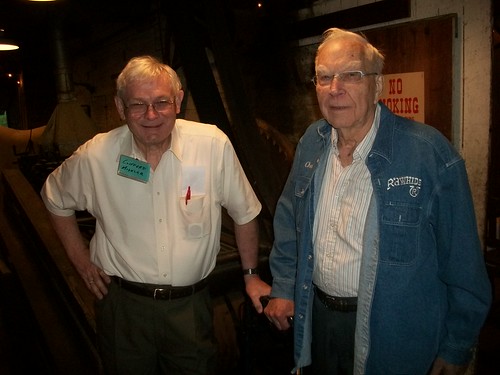
Clifford Mishler and Chester Krause
Dave Harper
It is probably appropriate that I was on the road when he passed as no individual was more responsible for opening my eyes to the wider world than was Chet.
Even though I wrote a blog in early April that he was in a bad way, like many times previously he had bounced back again and returned to his routine of going to his office on Main Street.
The last time I had coffee with him, some of the conversation of the four of us present was about how many caregivers he was going through. He always retained a sense of humor.
The numismatic world has lost a giant.
He did not like to be called Mr. Krause as I found out when I first addressed him as boss in 1978.
As the name of a book that was later written, he wanted to be called just plain Chet.
So Chet I called him.
I subscribed to his products as a kid, both Numismatic News and Coins Magazine. I went to work for him after college.
Through both aspects of my life in numismatics, Chet introduced me to the wider world.
Now it is time for me to pay respect as it is for others whose lives he enriched.
It is time to say thank you for a life well lived.
Thank you, Chet.
To read the complete article, see:
We’ll miss you, Chet
(www.numismaticnews.net/buzz/well-miss-you-chet)
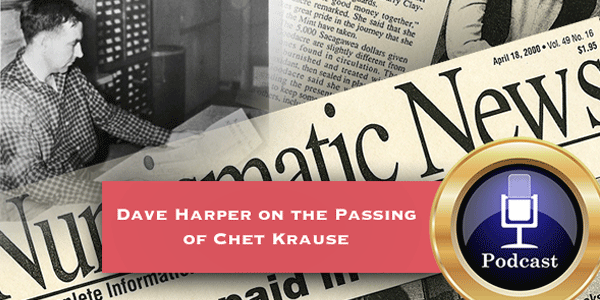
To read the complete article, see:
CoinWeek
Podcast #34: Numismatic News Editor Dave Harper on the Passing of Chet Krause
(www.coinweek.com/recent-articles-video/coinweek-podcast-34-numismatic-news-editor-dave-harper-passing-chet-krause/)

Numismatic News Staff
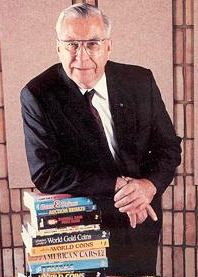 The first issue of what became a monthly and then weekly periodical was published Oct. 13, 1952. It originally sold for $2 a year. It
helped revolutionize numismatics and changed his life. He went from rural carpenter/building contractor into a pioneering hobby publisher.
The first issue of what became a monthly and then weekly periodical was published Oct. 13, 1952. It originally sold for $2 a year. It
helped revolutionize numismatics and changed his life. He went from rural carpenter/building contractor into a pioneering hobby publisher.
Mr. Krause picked up on a need for ever increasing speed in numismatic business and communications, yet remained loyal to his hometown of Iola, Wis., which even now has a population of only 1,300.
It was this rural isolation, far from the urban areas that hosted coin shops and shows, that brought him to believe that many other collectors shared the same needs he had.
He was right. That single insight proved to be timely. It eventually became the basis of a large publishing business called Krause Publications serving collectors in many other fields beyond numismatics.
Numismatic News grew with coin collecting to the highs of the roll and bag boom that peaked in 1964. He acquired a magazine in 1962 that he renamed Coins. The numismatic recession that hit in 1965 along with clad coinage nearly cost Mr. Krause the company.
He sold his coin collection to support the business. He founded a new title, Coin Prices, in 1967, but soon he reached beyond coin collectors and it was this diversification that set off a period of consistent growth.
In 1971 he founded, Old Cars, a paper for car collectors. His business vision took him into other collectible fields that ranged from sports cards and comic books to firearms, antiques and paper money.
If there was a collector of something, there was a need for a price guide. Mr. Krause compiled the Standard Catalog of World Coins first published in 1972 and it became the bedrock resource for the world's many coin collectors and dealers. Today, the Krause-Mishler catalog numbers named after him and his co-author, Clifford Mishler, are the basis of the world coin identification system.
To read the complete article, see:
Hobby publisher Chet Krause dies
(http://numismaster.com/ta/numis/Article.jsp?ad=article&ArticleId=28265)
Connor Falk and Others
Chet Krause’s positive attitude and dedication to numismatics is his lasting legacy to a coin collecting hobby he cared deeply for.
Jeff Garrett, president of the American Numismatic Association, said he appreciates his time serving with Chet Krause on the ANA board.
“I liked Chet’s wit and wisdom,” he said. “I worked with him during some trying times in the ANA. He was one of the guys who could cut to the chase, get to the nitty-gritty, a no-nonsense type of person.”
Chet Krause changed the industry when he formed Krause Publications, he said.
“He was a great businessman,” Garrett said. “I think that’s the way he wanted to have been remembered: as a great businessman. Numismatic News has a great legacy. This was someone who created something that is still around. I still read Numismatic News today.
“I think his biggest impact was the Standard Catalog of World Coins series. Those books transformed the market at a time where information on world coins was difficult to find. It was a giant effort.”
Chet Krause’s own collecting brought him to sales and shows often, Garrett said.
“I admired seeing his paper money collection when it went to auction in 2008,” he said. “He collected a lot of Wisconsin National Bank Notes. It was inspirational to see him assemble such a collection while also working in the business.
“I always enjoyed seeing him at coin shows. He traveled often. I would see him on the bourse floor and he’d stop over to say hello and chat for a bit.”
Harvey Stack, founder of Stack’s Bowers, successor firm to New York’s venerable Stack’s, said he has fond memories of Chet Krause going back to before Numismatic News.
“It was 1951 when Chet came into the store and asked, ‘Do you think I should start a coin newspaper?’” Stack said.
Chet Krause founded Numismatic News a year later.
Ken Bressett, editor of A Guide Book of United States Coins, said he admires Chet Krause’s focus on advancing numismatics.
“I think his work impacted the whole hobby,” he said. “I knew him before he started the magazine. He was way ahead of his time in his thinking and in his attempts to stimulate the hobby. Numismatic News is his greatest contribution. Way above anything else. His Standard Catalog series was also very useful, but I think Numismatic News was his pride and joy.”
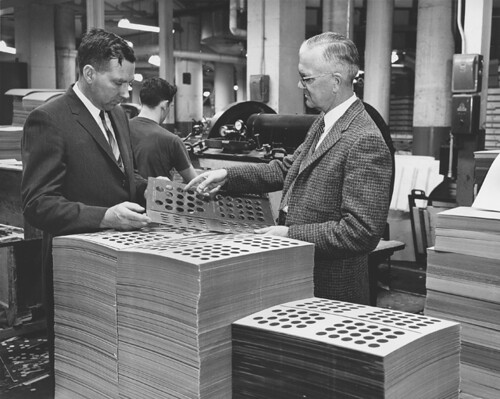
Two giants of numismatics from Wisconsin were
Chet Krause of Iola, left, and R.S. Yeoman of Racine, right.
To read the complete article, see:
Chet fondly recalled
(www.numismaster.com/ta/numis/Article.jsp?ad=article&ArticleId=28268)
Obituary
Lifelong Iola resident and perhaps its best-known citizen, Chet Krause, 92, died June 25 of complications of congestive heart failure. At the time of his death he was under hospice care at Iola Living Assistance where he had been admitted June 22.
Chester Lee Krause was born Dec. 16, 1923, in Helvetia Township, rural Waupaca County, about six miles east of the village of Iola. He was the youngest of six children born to Carl and Cora (Neil) Krause. His education began in a one-room schoolhouse that had been built by his father next door to the family farm. From an early age, Chet learned the building trades working with his father who was an accomplished stone mason. He attended high school in Iola, graduating in 1941.
In October, 1952, Chet published the first issue of Numismatic News. The paper was meant to fill a niche he had identified to serve coin collectors nationwide who were far removed from metropolitan areas. He was the prototypical customer for his new venture: a serious coin collector who was geographically cut off from that hobby's mainstream.
For the next five years the publication grew in advertising volume and circulation as Chet nurtured it on evenings, weekends and when inclement weather kept him away from current construction projects. In 1957, Chet finished the last building he would ever construct, a 40’ x 40’ brick and glass office a block off of Iola's Main Street. That would remain, with occasional additions as expansion dictated, the offices of Krause Publications for nearly two decades as Numismatic News and Krause Publications expanded through acquisitions and start ups of periodicals to fill identified needs in the coin collecting community.
Chet guided the growth of his publishing company through the 1980s, expanding into more that a dozen collectible hobbies and outdoors activities, producing dozens of periodicals and more than 150 book titles, with revenues approaching $100 million annually.
In retirement as he neared the age of 90, Chet spent much of his time writing monographs on subjects ranging from family and local history to a compendium of places named Iola throughout the U.S. These publications were a continuing facet of his lifelong goal to preserve historical information for future generations, whether they be coin collectors half a world away, or neighbors from down the block.
In January, 2014, Chet suffered a stroke that impaired his ability to read and write. He recovered much of his lost mobility and retained his generally upbeat attitude. He came nearly every day to his Main Street retirement office, remaining active behind the scenes in the planning and financing of village improvement projects. His office was a morning coffee-break meeting place for local friends, out of town visitors and former employees.
Among the most regular visitors to Chet’s office was his former right-hand man in the publications’ business, Cliff Mishler. Cliff maintains a Main Street office of his own just two doors down from that which Chet occupied. In retirement, Chet and Cliff were in almost as close a proximity as they had been for more than 40 years operating Krause Publications. Cliff remained a liaison to the numismatic world for Chet and continued to act as a sounding board on community affairs.
To read the complete article, see:
Chester
L. Krause (www.voiefuneralhome.com/fh/obituaries/obituary.cfm?o_id=3763168&fh_id=12037&lud=CE046A80BCD44155B21CF02E524A26BF)
To read the earlier E-SYlum articles, see:
CHESTER L. KRAUSE, 1923-2016 (www.coinbooks.org/esylum_v19n26a02.html)
CHET KRAUSE: THE AUTHORIZED INTERNET BIOGRAPHY
(www.coinbooks.org/esylum_v19n26a03.html)
THE BOOK BAZARRE
HARVEY STACK'S MEMORIES OF CHET KRAUSE
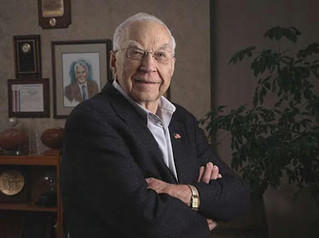 Creating Numismatic News
Creating Numismatic News
I remember when I first met him in 1961 when he visited Stack's in New York to sit down and talk to my Uncle J.B. (Joe Stack) to
discuss his idea of publishing a Coin Newspaper.
During the conversation with Chet, my uncle encouraged him to go ahead and publish a coin newspaper, weekly, which Chet was entitling NUMISMATIC NEWS. J.B. told Chet such a source of weekly news was really needed to encourage and inform collectors to learn more about their hobby. J.B. told him that there was a lack of current information then available, and he cited The Numismatist and Numismatic Scrapbook, but these were only published monthly and so the news was quite old.
The other major source for the general public was the Guide Book of United states Coins, Wayte Raymond's Standard Catalog (which was sporadic in issue), and some weekly editions of the New York Times, the Sun and the Chicago Tribune and sometimes the Washington Post would have a small article on a hobby page. So information on new issues was scarce, auction results hardly ever published, and there was a need to keep collectors more informed.
Chet hit on a great idea and J.B. endorsed and encouraged him to go ahead. Shortly thereafter the NUMISMATIC NEWS was born. J.B. said Stack's would like to be an early advertiser and we did become closer through the years.
Chet was a wonderful Numismatist and person to know. Whenever he made a trip into New York, Stack's was one of his stops, to visit the shop and chat with J.B. and the rest of the Stack's. At shows around the country he always came over to our table to say "Hello" inquire about the family.
Supporting Legislation
Chet supported me when I fought the government to lift the Gold Importation Regulation in force from 1961-67, implement the Hobby
protection act of 1973, (where I was the industry representative).
He was also a staunch supporter of my idea submitted to Congress in 1995 to make a circulating commemorative coin, THE STATEHOOD COMMEMORATIVE ISSUE, which was helpful to get the legislation passed.
Numismatic Hero
As I got older and saw Chet go from a cane, to a wheelchair and then drive his own motorized cart about the convention and show halls. I
said to myself, there goes a "hero" for coin collecting. I always had a tear in my eye as I watch him grow frail, but always was
thankful for his retaining, I'm sure to the day he passed on, his sharp mind and sense of humor, for which we all should try it imitate
and do for ourselves.
Chet was 4 years older than me, but he always made me feel young. I will miss my wonderful Midwesterner, who taught and listened to all and will surely be missed dearly by all who had the pleasure of knowing him.
My sincere condolences to his family, friends and all who had known him for a moment or for a lifetime.
SELECTIONS FROM DAVE WNUCK'S 'MAKING THE GRADE' #28
Dave's 10 inexpensive collections to put together that you may not have thought of before
- A set of choice uncirculated Eisenhower dollars (finding nice ones is tougher than you think, believe it or not),
- A set of clad business strike Washington quarters (same comment. The mints took no care in making these),
- A collection of 150 different varieties of Connecticut coppers (you can probably find 150 different for less than $200 each),
- A 50 piece set of classic commemorative half dollars. The spreads between grades are so small that you can crack them out of their slabs and put them in capital plastic holders if you wish. Or, you can collect them with their original packaging and ephemera that they came with – if you can find it. Much of that ephemera is harder to find than the coins themselves.
- A set of gold classic Commemoratives. A completable set (if you ignore the two $50 gold coins, as most people do), and they are getting no love at the present moment.
- A date set of US half cents.
- A denomination set of Mexican/South American Reales from ½ real to 8 Reales. You can do both the pillar style and the portrait style coinage. Most likely these were the coins you would spend if you lived in America in the 1700's and early 1800's.
- A set of nice uncirculated Franklin half dollars, not paying attention to full bell lines. Brilliant or attractively toned – or both.
- A set of Standing Liberty Quarter's in uncirculated, not paying attention to full heads. You can get mostly full heads on most of the dates for little or no premium, and these are great looking coins.
- A collection of contemporary counterfeit 2 reales. This recommendation is a bit self-serving, but is a great way to get a sense of history and to collect items that are extremely rare, though not very expensive. Rarity 7 (4 to 12 specimens known in all grades) is a typical rarity rating for coins in this series, and unique coins often cost below $1000. The most expensive 2 reales counterfeit ever sold at auction was less than $2000. Perhaps not coincidentally, that very coin is being offered in this issue (see below). There is a US connection to these coins even though they seem to be "foreign" at first glance, as many were made in America to circulate in the American colonies and in the newly formed United States in the early 1800's.
1863 Princess Alexandra Medal
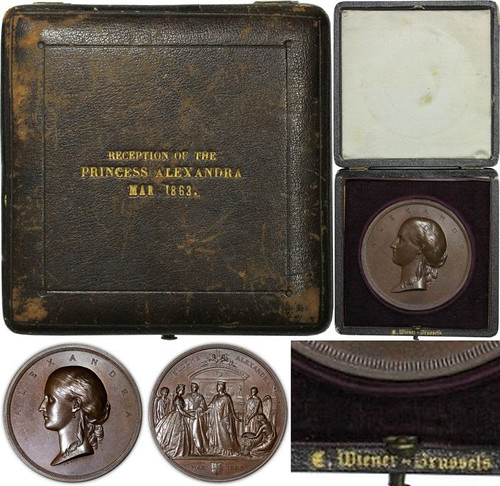
1863 Medal in Specially Inscribed Presentation Case, Engraved by Charles Wiener. Uncirculated [uncertified].
Presented on the occasion of the Reception of the Princess Alexandra, March 1863. Apparently this was the wedding of the Century, at least according to the book I found on the Internet that is devoted entirely to a description of this wedding. In detail. In minute detail, in fact. A beautiful medal crafted by the youngest of the three Wiener brothers, all three of whom (Jacques, Leopold and Charles) were skilled medal engravers. $375.
1896 Chain Pier Silver Medal
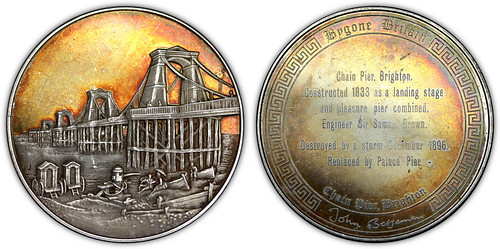
1896 Chain Pier Silver Medal. Uncirculated [uncertified].
I bought this medal for the beautiful toning. The way the golden orange toning lays on the obverse, it looked to me like a calming sunset with the pier in the foreground. I showed it to someone else though, and he thought it looked like London was burning in the distance. As a lifelong fan of the punk band, The Clash, I will accept that interpretation as well. $245.
Enameled 1925 Norse Silver Medal
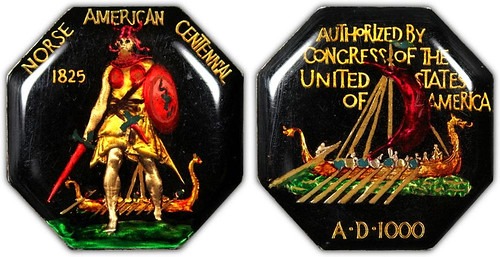
1925 Norse Medal. Silver. Enameled. Uncirculated [uncertified].
This was carefully and expertly made on a thick planchet silver medal. The first I have ever seen on a Norse medal. $225.
1925 Norse Gold Medal
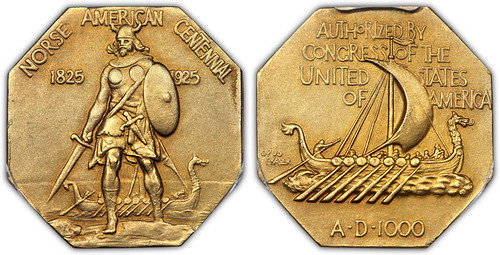
1925 Norse Gold Medal. PCGS graded Proof 66 CAC.
PCGS has only graded two coins finer than this. Only 47 pieces (net of melting by the Philadelphia Mint) were made, and far fewer are known today. It is interesting to speculate that if the US Mint chose to make proof versions of gold coins in the 1920's they very likely would have done it in the matte proof finish, as shown here. $39,500.
To read the complete newsletter, see:
Making The Grade #28: The Everyman
Issue (http://us10.campaign-archive1.com/?u=648e8b4522a9e91a13d18de6a&id=bf007b03e7&e=c715309517)
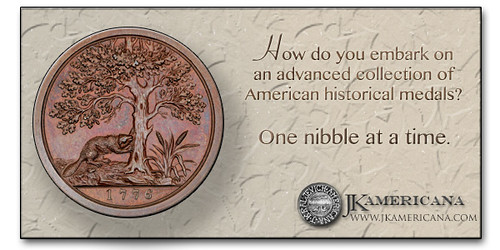
SELECTIONS FROM 2016 HERITAGE SUMMER FUN SALE
Lot 3002: 1652 6PENCE Pine Tree Sixpence, Pellets at Trunk, Crosby 1-A
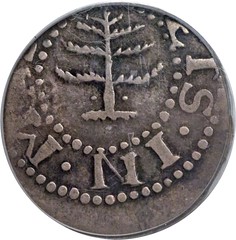
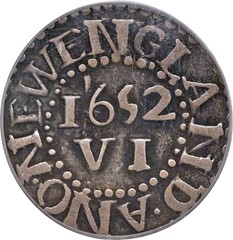
1652 Pine Tree Sixpence, VF30
Noe-33, Well-Centered Reverse
1652 6PENCE Pine Tree Sixpence, Pellets at Trunk, VF30 PCGS. CAC. Crosby 1-A, Noe-33, W-670, R.3. A cream-gray piece that has glimpses of darker toning within crevices of the designs. The obverse is misaligned toward 11 o'clock, diagnostic for Noe-33. Later dies with a vertical break between the 16 in the date. Moderately wavy from striking with rocker dies, but wear is even aside from the obverse at 9 o'clock. Listed on page 41 of the 2017 Guide Book.
Ex: Central States Signature (Heritage, 5/2007), lot 9; FUN Signature (Heritage, 1/2012), lot 3943.
To read the complete lot description, see:
1652 6PENCE Pine Tree Sixpence, Pellets at Trunk, VF30 PCGS. CAC. Crosby 1-A, Noe-33, W-670, R.3....
(http://coins.ha.com/itm/colonials/1652-6pence-pine-tree-sixpence-pellets-at-trunk-vf30-pcgs-cac-crosby-1-a-noe-33-w-670-r3/a/1237-3002.s?ic4=ListView-ShortDescription-071515)
Lot 3006: Nova Constellatio Copper 5% Off-Center
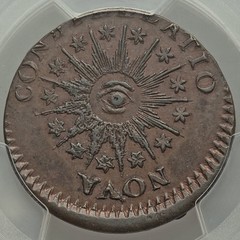
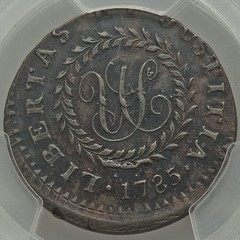
1785 C NOVA Nova Constellatio Copper, Pointed Rays, Large Date -- Struck 5% Off Center -- AU53 PCGS. Crosby 3-B, W-1895, R.2. Off center several degrees toward 12 o'clock, with portions of the upper legends off the flan. NOVA CONSTELLATIO exhibits strike doubling. An unabraded and impressive chocolate-brown example. A middle die state with moderate crumbling on the lower obverse. Listed on page 56 of the 2017 Guide Book.
To read the complete lot description, see:
1785 C NOVA Nova Constellatio Copper, Pointed Rays, Large Date -- Struck 5% Off Center -- AU53 PCGS. Crosby 3-B, W-1895, R.2....
(http://coins.ha.com/itm/colonials/1785-c-nova-nova-constellatio-copper-pointed-rays-large-date-struck-5-off-center-au53-pcgs-crosby-3-b-w-1895-r2/a/1237-3006.s?ic4=ListView-Thumbnail-071515)
Lot 3737: 1795 Cent Talbot, Allum & Lee Cent
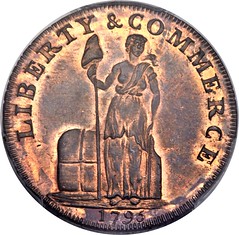
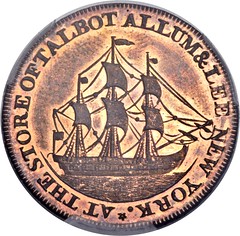
1795 Talbot, Allum & Lee Cent
PR65 Red and Brown, Fuld-1
1795 Cent Talbot, Allum & Lee Cent PR65 Red and Brown PCGS. Fuld-1, W-8620, R.1. Talbot, Allum, and Lee were New York merchants, heavily engaged in trade with India in the 1790s. The 1794 and 1795-dated coppers bearing their names were actually produced in England, and British numismatists collect them as Conder tokens.
Proof specimens, like the present coin, are much more elusive than business-strike examples. This delightful Gem offers virtually pristine original red surfaces that have mellowed to light brown in selected areas. The design elements are sharply detailed and the fields are deeply reflective, under the patina. Listed on page 78 of the 2017 Guide Book.
To read the complete lot description, see:
1795
Cent Talbot, Allum & Lee Cent PR65 Red and Brown PCGS. Fuld-1, W-8620, R.1....
(http://coins.ha.com/itm/colonials/1795-cent-talbot-allum-and-lee-cent-pr65-red-and-brown-pcgs-fuld-1-w-8620-r1/a/1237-3737.s)
THE WILLMOTT-OGHIGIAN 1792 SILVER CENTER CENT
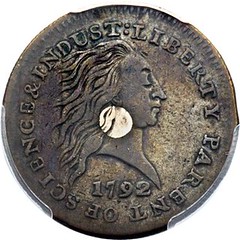
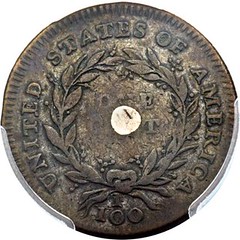
1792 Silver Center Cent, Judd-1, SP35
First Coin Struck Inside the U.S. Mint
Classic American Rarity
1792 P1C One Cent, Judd-1, Pollock-1, High R.6 SP35 PCGS Secure. The Silver Center cent is one of the most famous and iconic issues of American coinage. Most numismatists believe it was the first coin actually produced inside the walls of the first U.S. Mint, although a few other patterns were struck earlier, before the Mint was actually ready for coinage operations. Its historic importance can scarcely be overstated and examples have been prized by collectors since the earliest days of the hobby.
Origin of the Silver Center Cent
The Silver Center cent was long thought to be the brainchild of Chief Coiner Henry Voigt, based on Thomas Jefferson's famous message to
President George Washington on December 18, 1792:
"Th. Jefferson has the honor to send the President two cents made on Voigt's plan by putting a silver plug worth ¾ of a cent into a copper worth ¼ of a cent."
However, recent research by Len Augsburger, Joel Orosz, and Pete Smith for their coming book, 1792 Birth of a Nation's Coinage, indicates the concept for the unique dual metallic composition of this piece may have originated with famous patriot and essayist Thomas Paine. Paine was living in London when he sent Jefferson a September 28, 1790-dated letter outlining his ideas for a national mint and coinage. Despite the obvious advantages of copper as a metal for coinage (inexpensive and easy to work with), Paine believed that "to give the cents the intrinsic value they ought to have by weight, they will be too heavy and bulky for the use they are intended for." He suggested three possible solutions to this problem:
"1st. Making silver and copper in fusion; 2d. Plating the copper with silver; 3d. Plugging the copper with silver. But against all of these, there are very capital objections."
The Mint would actually try two of Paine's three suggestions in 1792, in the form of the Silver Center cent (Judd-1) and the Fusible Alloy cent (Judd-2). As Paine predicted, both of these solutions proved impractical for actual coinage. The Fusible Alloy cents were indistinguishable from pure copper cents and thus highly vulnerable to counterfeiting, and the mechanical problems encountered when preparing and striking the copper cents with a silver plug were too great to overcome in high-volume coinage operations. The Mint recognized these difficulties almost immediately.
It seems the few specimens actually struck were primarily intended as essay pieces, to demonstrate the design to President Washington and members of Congress. Modern testing reveals that most (if not all) of the Fusible Alloy cents were actually struck in pure copper and measurements of the silver plug on the Silver Center cent indicate it was too small to contain ¾ cent worth of silver. No Silver Center cents were ever produced for circulation and no official mintage figures have ever surfaced. Today, we know of 14 surviving examples, most of them in relatively high grade, and a single copper setup piece struck without the silver plug.
The Present Coin
The coin offered here is a fairly recent discovery, found in a pub in the 1960s. The first owner of record was named Nigel Willmott and it
has one previous auction appearance in a Glendining's sale in 1997, where it brought 28,750 British pounds. It passed through a number
of well-known American numismatists and coin dealers, including Kenneth Goldman, Stuart Levine, and Anthony Terranova, before finding a
home with prominent collector Martin Oghigian. This piece has been in Oghigian's estate since his death in 1998.
To read the complete lot description, see:
1792 P1C One Cent, Judd-1, Pollock-1
(http://coins.ha.com/itm/patterns/coming-soon-/p/1238-181004.s)
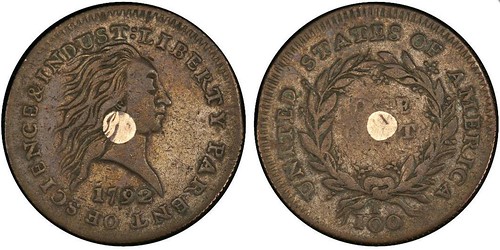

ROSENBLUM SALE 46A CLOSES JULY 11, 2016
William M. Rosenblum’s much anticipated annual summer auction catalog is now open. One of the world’s most prominent foreign and ancient numismatists, Rosenblum’s catalog 46A features a selection of rare and seldom offered Ancients, World, Israeli, Paper Money as well as literature. Now open for bidding, the auction closes Monday, July 11th at 9PM MT. Collectors, dealers and interested parties can visit http://rosenblumcoins.com/46a to see the offerings.
This is Rosenblum’s third mail auction catalog coined “The Philadelphia Collection.” A majority of the items belonged to a Philly businessman and numismatic aficionado, whose portfolios of rarities were collected over the last 40 years.
PART ONE: WORLDWIDE MATERIAL
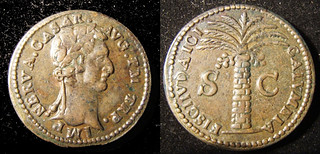
Ancients - The Ancient section includes a choice EF slabbed Athenian Owl, a scarce Judaea Capta sestertius variety, a nice Paduan Type Nerva Fisci Ivdaici sestertius, and some NGC slabbed mint state coins, among others.
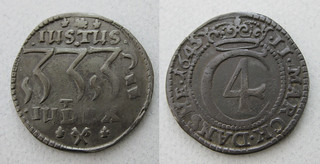
World - The World section contains a very nice selection of medals from around the world including neat Austrian, British and US medals. There are numerous examples of metallic (and plastic) WWII internment camp tokens some of which he has never been offered.
Mexico is well represented with four different 4 reales of Carlos and Johanna, a 1776 dated 8 Reale plus numerous other rarities, many of which have been certified. The Palestine section, while small, has a rare Zichron Yakov Piastre token, a mint state 1933 100 Mil silver coin and numerous other high grade coins.
Throughout this section bidders will also find crowns, minors, tokens and medals from Latin America and Europe as well as some extremely rare, and in most cases, high grade items from Egypt, Liberia, Mombasa, Morocco, Mozambique, Senegal and Sierra Leone. There is also a nice run of United States medals including a huge plaster cast of Louis Brandeis, a few ANS issues (including one by Brenner) and an ANA exhibit award medal given to the famed Aaron
Israeli - Numerous rare coins seldom offered are among the Israeli coin section, led by a 50 Pruta 1954 with an inverted reverse which Rosenblum has never seen before. The section also includes an exceedingly rare 1960 Eight-Grain 1 Agora pattern, two rare 1 Agora proofs from the early 1960s, six different 1949 proof striking from the ICI mint archives, and a 1952 10 Pruta in Proof.
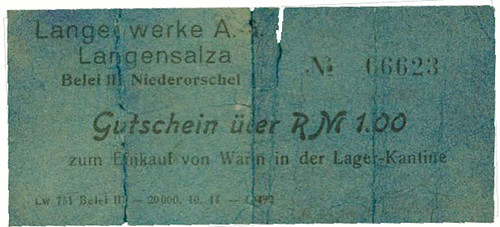
Paper Money - Among Rosenblum’s finest in years, the paper money section contains numerous WWII internment camps, concentration camps, DP camps and POW camp rarities from places such as Camp Hay in Australia, Buchenwald, Langenwerke, Mittelbau (5 different pieces), Neuengamme, Kenya, Lithuania (4 different lots), Herzogenbusch, the Netherlands occupation of Germany, New Caledonia and the Warsaw Ghetto. A number of the notes have been slabbed as well.
Literature - Nine lots of numismatic literature, some never offered before by Rosenblum, and others that are vital books and auction catalogs that collectors at any level can refer to almost daily.
PART TWO: JUDAIC AND HOLY LAND RELATED MATERIAL
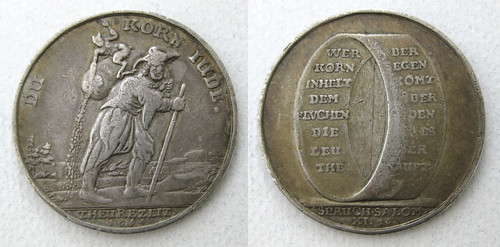
Auction 46A’s medallic Judaica offerings include: two David and Goliath jetons, a rare silver Korn Jude medal of Christian Wermuth and three very unusual and scarce “False Shekel” types one of which is silver. The section also includes numerous synagogue medals from the old and new worlds, a medal of Rabbi Henri Loeb, a scarce 1933 medal advertising a Nazi visit to Palestine, and an exceedingly rare 1967 Paratroops Brigade medal.
The paper section includes a letter from Alfred Dreyfus to the widow of Emile Zola and a number of WWI era emergency issues used as the Ottoman Empire was disintegrating.
About A full time professional numismatist since 1973, Rosenblum deals in all aspects of ancient, medieval and modern coins, tokens, medals and paper money of the world. A specialist in all aspects of Israel, Palestine and Jewish related numismatic material ancient to modern, he has written, researched and bought and sold Holocaust related material for over four decades. A frequent speaker on coins and banknotes, as well as a past instructor at the American Numismatic Association’s Summer Seminar teaching a course entitled “Numismatics of the Holy Land from Ancient to Modern Times” Rosenblum is often called upon by museums, lawyers, banks and insurance companies for attesting to market values and authenticity of coins. He was chosen twice to appraise the famous Kagan Maremba collection of Israel and Palestine coins.
Rosenblum is a member of more than a dozen numismatic organizations and clubs, including the ANA, the ANS and the International Association of Professional Numismatists, a group consisting of only 120 members world-wide. He has published over 250 auction catalogs and fixed price lists over the plus-40 years, selling numerous “name” collections including all or part of those of Morty Zerder, Morris Bram, Saul Sugar, George Fisher, Bill Spengler, David Donald, Mark Bir, Guido Kisch, Bob Schonwalter and of course “Mr. Philadelphia”. For more information, visit http://rosenblumcoins.com/.
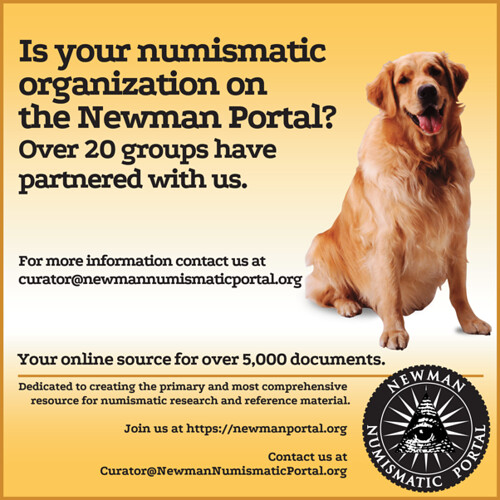
SOTHEBY’S SELLS SET OF PICASSO’S SILVER PLATES
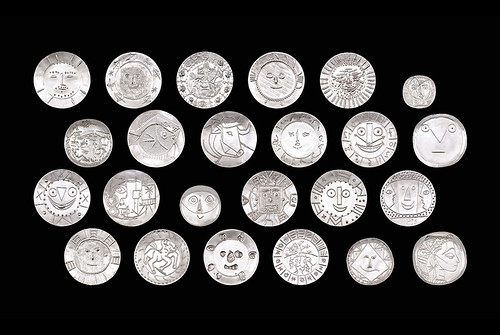
Over the past decade or so, Picasso’s ceramics have soared in popularity – and price – but it is less well known that he also crafted 24 different silver plates between 1956 and 1967, each cast in a limited edition of 20. Now, for the first time, a complete set of the plates is being auctioned, in Sotheby’s Hong Kong’s Boundless: Contemporary Art sale on Thursday June 23, with viewing from Friday June 17 onwards. They are estimated at HK$12m-HK$18m (about £1.09m-£1.63m).
Picasso began working in ceramics in 1946, after attending the annual potters’ exhibition in Vallauris, France, but it was not until a decade later that he commissioned the master craftsman François Hugo – Victor Hugo’s great-grandson – to cast a series of designs in gold and silver based on the ceramic originals. Initially they were for Picasso’s enjoyment alone, hidden from the public and shown only to a small circle of intimates, but in 1967 Picasso authorised Hugo and his son Pierre to make small, numbered editions of each plate.
Even then their existence remained largely unknown outside a small number of connoisseurs until they formed part of the centrepiece of the 1977 solo exhibition Picasso – 19 Silver Platters at London’s Lever Galleries and Paris’ Galerie Matignon. They caused a sensation, and contributed to the growing recognition of Picasso’s non-painting works. “These unique silver plates cast an intimate light on Picasso’s artistic production of the 1950s,” says Isaure de Viel Castel, head of Boundless sales, Sotheby’s Hong Kong. “Picasso chose not to share these plates with the public, reserving them exclusively for his family and friends. It’s thrilling to have the opportunity to reunite them as a complete group for the first time at auction. Picasso’s ceramics share a similar iconography, but by casting in silver, he references the grand tradition of French and Italian silverware. Three centuries on from the legendary silver furniture and silverware made for Versailles, Picasso breathes life into this sumptuous French tradition.”
The designs are inspired by three themes: Henri Matisse, bullfights and his second wife Jacqueline Roque. The influence of Matisse shines through in the design Visage aux Feuilles, a whimsical face surrounded by simple lines in a manner reminiscent of Matisse’s later drawings and cutouts; the bull, a frequent preoccupation of Picasso, features in the design Taureau; and Roque, his muse at the time, appears in the design Profil de Jacqueline.
To read the complete article, see:
Bid for a full set of Picasso’s 24 silver
plates (http://howtospendit.ft.com/art/108443-bid-for-a-full-set-of-picassos-24-silver-plates)
To read the complete article, see:
http://artdaily.com/news/86864/A-complete-set-of-24-Picasso-silver-plates-to-lead-Sotheby-s-HK-s--Boundless--Contemporaty-Art-Sale-#.V3EZUbgrLNM
(http://artdaily.com/news/86864/A-complete-set-of-24-Picasso-silver-plates-to-lead-Sotheby-s-HK-s--Boundless--Contemporaty-Art-Sale-#.V3EZUbgrLNM)
To read the earlier E-Sylum articles, see:
SOME RECENT AUCTION ITEMS: INDIAN PEACE AND PICASSO MEDALS
(www.coinbooks.org/esylum_v17n51a13.html)
MORE ON THE PABLO PICASSO SILVER AND GOLD MEDALS
(www.coinbooks.org/esylum_v17n52a12.html)
SOTHEBY'S SELLS TROMPE L’OEIL BANKNOTE PAINTINGS
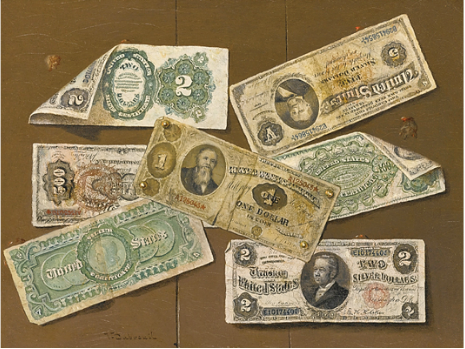
It is not unusual to have one American trompe l’oeil painting depicting money in an auction, but to have three is a rather unusual occurrence. Sotheby’s June 9 American Paintings, Drawings and Sculpture auction in New York City realized just over $4 million and included several lots of interest to numismatists.
All three were offered without reserve — meaning that the consignor, in this case an unnamed corporate collection — did not set a minimum price. The first, A Few Bills by Victor Dubreuil, sold for $20,000, sailing past its estimate of $4,000 to $6,000.
The painting depicts seven U.S. notes attached to a wall. Among the notes depicted are an 1891 $1 silver certificate, an 1886 $5 silver certificate and an 1891 $2 silver certificate.
As the artist did not have high denomination notes to work from, he often created fantasy notes for larger bills. Dustin Johnston, director of currency at Heritage Auctions, pointed out that this painting has a fantasy $500 legal tender note and a fantasy $100 silver certificate with design elements from an 1886 $1 silver certificate. At the center is an 1891 $1 Treasury note.
Johnson added, “These trompe l’oeil paintings depicting money are a window into time, revealing what was actually in circulation. The cross section of currency in the painting points to how scarce the high denominations were. While most artists portrayed the small denominations with incredible accuracy, few painters have ever accurately depicted notes at the $100 level or higher indicating that they were far out of reach for the common man.”
The term “trompe l’oeil” is a French term that means “trick” or “fool the eye.” It is the name for a painting style that is highly realistic and utilizes optical illusions so that the viewer is unsure of what is painted and what is real.
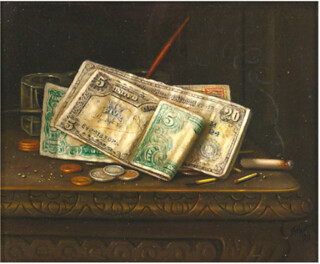 A still life of paper money and coins by Charles Alfred Meurer (American, 1865 to 1955) was estimated at $1,500 to $2,000 and brought a
massive $10,625. The small oil on canvas was signed by the artist and dated 1913 in the lower right. It had been in a private collection in
Cincinnati and was acquired by the corporate collection in 1992.
A still life of paper money and coins by Charles Alfred Meurer (American, 1865 to 1955) was estimated at $1,500 to $2,000 and brought a
massive $10,625. The small oil on canvas was signed by the artist and dated 1913 in the lower right. It had been in a private collection in
Cincinnati and was acquired by the corporate collection in 1992.
The painting depicts a bundle of money including an 1899 $5 silver certificate, an 1899 $1 silver certificate and a 1902 $20 national bank note with Charter Number 24. Johnston noted that the charter number identifies it as being issued for a Cincinnati national bank.
Unlike the notes, the coins are not painted with sufficient specificity to allow for any attribution as to type or even denomination.
Fumes from a lit cigar at the edge of the painting enliven the picture.
Meurer spent much of his career in Terrace Park, Ohio, a suburb of Cincinnati, and maintained a studio there for many years. He was well-known for his realistic depictions of money and paintings with hunting motifs.
As Alfred Frankenstein wrote in his book After the Hunt: William Harnett and Other American Still Life Painters, 1870–1900, “This mode of still life painting was later described as editorial-sanctum still life, something that emphasizes with appropriate objects authority (books), industry (pen and inkwell) and respectability (money). Many journalism offices today have paintings or copies of them with that motif.”
To read the complete article, see:
Sotheby's auction of
paper money and coin paintings yields big bucks
(www.coinworld.com/news/paper-money/2016/07/sothebys-paper-money-paintings-big-bucks.all.html)
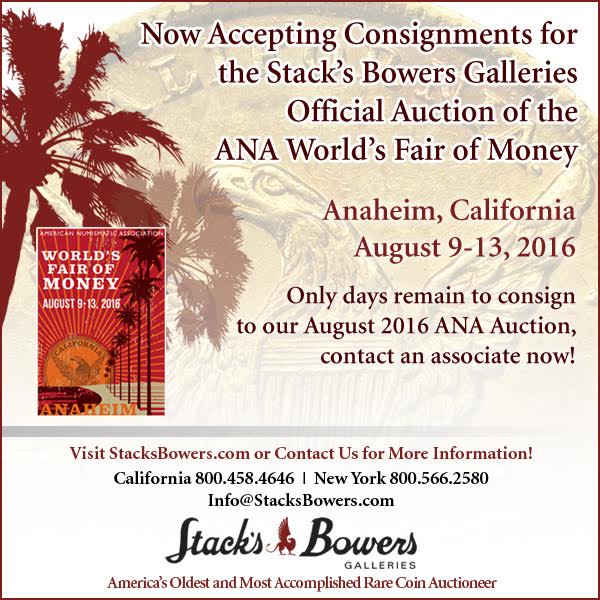
BRITISH ARCHAEOLOGISTS ARE RUNNING OUT OF STORAGE
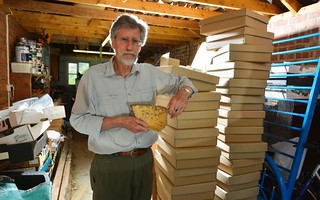 Britain risks losing a large part of its precious historical heritage as archaeologists are forced to dump their finds because of a lack of
storage space.
Britain risks losing a large part of its precious historical heritage as archaeologists are forced to dump their finds because of a lack of
storage space.
Thousands of objects which could shed light on the lives of our ancestors - such as Roman pottery fragments, Stone Age flints, medieval coins and animal bones – are being abandoned or lost because there is nowhere to store them properly.
Archaeology groups have now warned the country is in danger of “forgetting its own past”.
The problem is having a particular impact on community archaeology groups who have been told that cuts in funding mean local museums can no longer afford to store and curate their finds.
That has forced them to return the objects to the owners of the land from where they were first excavated, running the risk they will be lost forever when people move home or simply become fed up with storing the material.
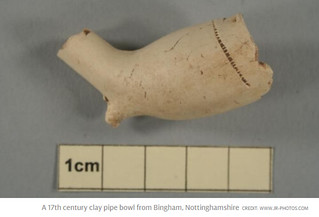 In more extreme cases thousands of historical fragments are simply being dumped in skips.
In more extreme cases thousands of historical fragments are simply being dumped in skips.
Objects from digs are frequently lost simply because it was not stored properly and nobody can remember where it was kept.
Professor Carenza Lewis, of the University of Lincoln, said: “Material is being lost all the time. In many cases it has been thrown away because the people who gathered and collated the objects have moved on or died and their children or executors come across what they might regard as a load of junk and throw it out.
“The problem is getting worse because country councils have lost funding and museums have shut down or don’t have the staff to curate and look after archaeological finds.”
In Nottinghamshire the Bingham Heritage Trail Association (BHTA), which has excavated some 14,000 historic objects and fragments in the past two years as part of the market town’s community dig project, has been forced to return them to the owners of the properties in whose grounds they were found.
The pieces - a mixture of Roman and Anglo-Saxon pottery and tile fragments, Mesolithic and Neolithic flint work and 16th century wine bottles and animal bones - have been catalogued and placed in museum boxes before being returned.
To read the complete article, see:
Britain may lose
historical heritage as archaeologists admit there is not enough storage space for finds
(www.telegraph.co.uk/news/2016/06/25/britain-may-lose-historical-heritage-as-archaeologists-admit-the/)

TYRANTS COLLECTION ADDS 1344 EDWARD III DOUBLE LEOPARD
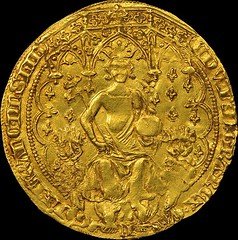
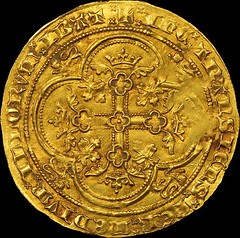
Numismatic Guaranty Corporation® (NGC®) has certified a 1344 Edward III “Double Leopard” that recently sold privately for the highest price ever paid for an English coin. Graded NGC MS 62, it is the only example of this important gold coin in private hands.
The Double Leopard, named for the two leopards featured on the reverse, was struck in 1344 as England’s first large-sized gold coin. Until that time English coinage was exclusively silver save for a small number of tiny gold pennies struck in 1257. Gold coins needed for domestic and international trade had to come from other European countries such as France and Italy.
Edward III decided that England needed its own gold coins and in 1344, England then issued gold coins in the denominations of double-florin (double leopard), florin (leopard) and half florin (half leopard). The double leopard weighed 108 grains, or just under one-quarter of an ounce, to mimic the French florin then in common use. It was assigned a value of six shillings.
The gold leopard coinage was extremely short-lived. Struck between January and July of 1344, they were quickly abandoned in favor of the gold noble, which was a bit larger than the double leopard with a weight of 138.46 grains and a value of 6 shillings, 8 pence. The gold noble gained popularity and on August 20, 1344, the gold leopards were officially demonetized.
Few gold leopards were struck and it is likely that many were melted. In fact, the double leopard was thought to have been lost to time until schoolchildren found two examples in the Tyne River in 1857. Both pieces later became part of the British Museum, where they currently reside.
A third example—the piece recently graded by NGC—was discovered by a metal detectorist in southern England nearly 150 years later in 2006. It was subsequently sold at auction that year for the equivalent of $850,000, the highest price ever paid for a British coin at the time.
Ira Goldberg, co-owner of Ira & Larry Goldberg Auctioneers, was the under bidder at that auction, finally dropping out when the coin reached that astonishing price. A decade later, however, Goldberg was again presented with the opportunity to acquire this phenomenal rarity.
Goldberg seized the moment and purchased the coin for a client who is building a fantastic collection of important coins from England and other countries. The purchase price was not disclosed but Goldberg says that “it easily establishes this coin as the most valuable English coin of all time.”
The NGC MS 62 Double Leopard is now part of the Tyrants Collection, a fantastic assemblage of English and other world rarities.
To read the complete article, see:
NGC Grades Most Valuable English Coin
(/www.ngccoin.com/news/article/5394/1344-Edward-III-Double-Leopard/)
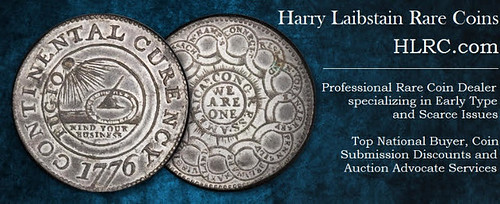
RUSSIAN SILVER PATTERN FROM MOLDAVIA & WALLACHIA
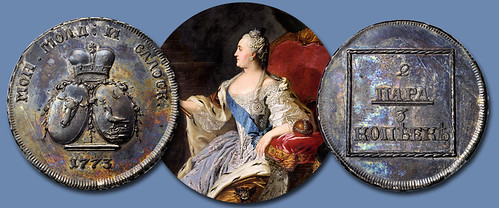
The Stack’s Bowers Galleries official August ANA World’s Fair of Money Auction is edging ever closer. For our preview in this final week of June we have a fantastic and exceedingly rare pattern coin produced in Russia during the reign of Empress Catherine II (the Great). Catherine II, though not a Russian by birth, became Empress following a coup d’état and the assassination of her husband, Emperor Peter III. Her accession came at the conclusion of the Seven Years’ War. Russia earned a place among the great powers of Europe under her rule, thanks to her strategy of revitalization and expansion. Her council of advisors, including nobles, generals and admirals, assisted her greatly in the expansion of Russia, both through diplomatic means and military conquest. Catherine continued what Peter the Great started: the modernization of Russia into a more Western European society.
This coin features the crowned arms of Moldavia and Wallachia within a garland of roses atop a pedestal with the date 1773 just below. The reverse displays the dual denomination of Para and Kopeks. Per the 2003 Diakov catalog, at one point Brekke had commented that only three examples had appeared at auction in the preceding century. Struck at Peter Gartenberg's estate in Sadagura (Garden Mountain [in] Slavic), there can be little doubt about the special status of this coin. Very well preserved and clearly struck from the freshest dies, this coin features exceptional strike details and gorgeous color. This piece is absolutely beautiful when viewed in hand and the plethora of blues along with the lilac; aquamarine and rose patina can be truly appreciated. This rare piece combines the numismatic rarity and visual beauty into a powerhouse coin that is guaranteed to bring pride to the most sophisticated of collections.
To read the complete article, see:
Exceedingly Rare Russian Silver Pattern from Moldavia &
Wallachia (www.stacksbowers.com/News/Pages/Blogs.aspx?ArticleID=2153)
SOUTH VIET NAM 1000 DONG BANKNOTE OFFERED
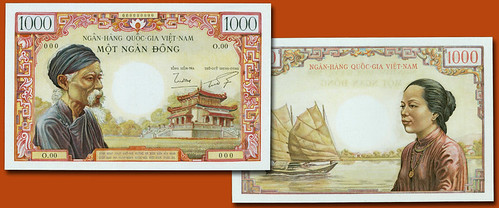
Our upcoming Hong Kong Auction will feature one of the most sought after pieces in World Currency collecting. Stack’s Bowers is pleased to offer the South Viet Nam P-4Ap 1000 Dong Proof for the first time in our history. This note is at the top of every serious collector’s list for multiple reasons: its beauty, design, scarcity and interesting history, as well as the high denomination and the degree of difficulty of obtaining an example, especially a gem.
This note was proposed to the government after the Thomas De La Rue Company was commissioned to create a piece that represented the essence of South Viet Nam. The Old Man was printed to signify dedication and longevity, while he stared at the temple that represented the religious sentiment of the region. On the reverse a stunning woman offers an aura equal to that of the Mona Lisa. The background displays a boat on a lake with a mountainous landscape -- a symbol of the beauty of the area. TDLR produced a few test creations and ultimately the proposed design on the featured note was chosen. Sadly, while this design was approved through the Proof and Specimen stages, it was never issued, most likely due to the war. It is only available as a Proof, or a Specimen. There are fewer Proofs available than Specimens, however Proof examples lack the unique watermark of the old man that when held to the light, is staring at the woman.
The note will be offered in our live session of the Hong Kong Paper Money Sale in August.
Howard Daniel adds:
The note will likely get bids over US$10,000 and maybe close to double that.
To read the complete article, see:
The Old Man at the Temple - The Holy Grail of World Currency
(www.stacksbowers.com/News/Pages/Blogs.aspx?ArticleID=2130)

VIDEO: THE MAKING OF THE NEW FIVER
The video (below) was released quietly on the same day that Governor of the Bank of England Mark Carney revealed the design of the new note, and has not had many views as yet.
It is the first time the Bank of England or De La Rue have released a video like this into the public domain.
“In the past, we have had B roll footage that we’ve given out on request, but I believe this is the first time that we’ve produced a video that just focuses on the printing aspect and released it ourselves,” said a Bank spokeswoman.
The video shows the polymer substrate prior to and after printing. The substrate is made by Innovia Films in Cumbria and is manufactured with a special transparent window that forms part of the security features in the note.
It also shows the application of hologram foils, UV curing of the finished sheets of banknotes and guillotining into individual notes, while at the same time being careful not to reveal too many details about the process or equipment involved.
The New Fiver will enter circulation in September.
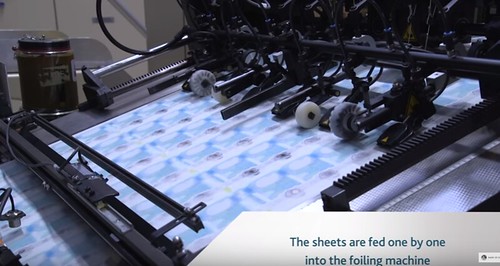
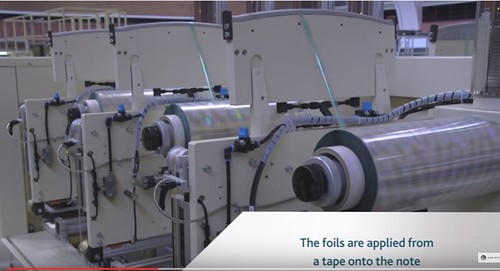
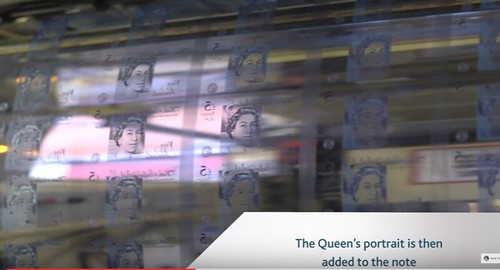
To watch the video, see:
The Making of The New Fiver (www.youtube.com/watch?v=eRbKkfkAH2s)
To read the complete article, see:
Glimpse into secret
world of banknote printing via YouTube
(www.printweek.com/print-week/news/1158013/glimpse-into-secret-world-of-banknote-printing-via-youtube)
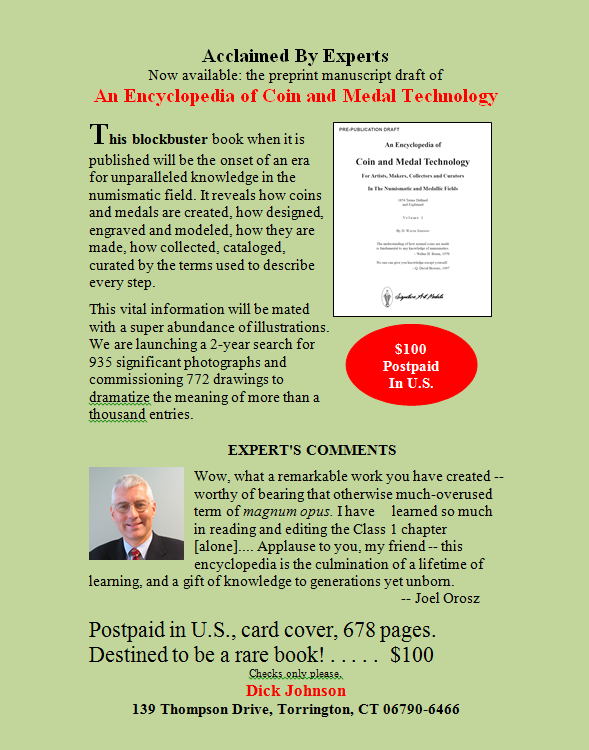
NORTH KOREAN COUNTERFEITING REVISITED
North Korea is suspected of restarting its counterfeit currency business after an agent from the secretive nation was arrested over the discovery of fake $100 bills paid in to Chinese banks.
The agent was held in Dandong, a city in eastern China bordering North Korea, amid claims he had exchanged $5million into Chinese currency before depositing the cash.
Fake notes were detected counting machines at the banks before the unnamed man was arrested and his accounts frozen, it has been reported.
The Telegraph reports South Korean newspaper JoongAng as saying the man admitted being part of the North's dictatorship under Kim Jong-UN.
A source reportedly said that the man had confessed to spying in the South.
The cash was due to have been spent on luxury house hold items - much sought after in the impoverished North - before being handed out by the dictator to some of his key backers.
To read the complete article, see:
Is North Korea back in the counterfeit currency business? Pyongyang agent is arrested after swapping fake $100 bills for Chinese money
(www.dailymail.co.uk/news/article-3663715/Is-North-Korea-counterfeit-currency-business-Pyongyang-agent-arrested-swapping-fake-100-bills-Chinese-money.html)
BELARUS CURRENCY REDENOMINATION
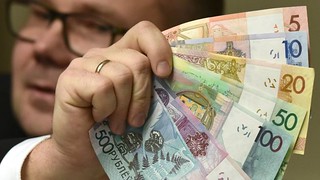 Belarusians are preparing for a major change in the way they handle money, with coins being brought back into circulation as part of a
currency redenomination.
Belarusians are preparing for a major change in the way they handle money, with coins being brought back into circulation as part of a
currency redenomination.
For years coins have been issued purely as collectors' items in Belarus, as rampant inflation has made small change redundant - the exchange rate currently stands at 20,000 roubles to the dollar. But from 1 July, existing banknotes will be replaced by a new mixture of coins and notes, all with much smaller denominations.
Under the new system, Belarusians will use notes valued between five and 500 roubles, and a range of lesser-value kopek coins. It means that if something cost 21,700 roubles under the old system, Belarusians will now hand over two roubles and 17 kopeks, the US-funded Radio Free Europe website explains.
Those struggling to get their heads around the change have a few months to work things out - the National Bank has said old and new banknotes will be in parallel circulation until the end of the year, and shops will have to show both prices. From the start of 2017, people will have to exchange their old notes for the new versions.
To read the complete article, see:
Belarus prepares for currency changes
(www.bbc.com/news/blogs-news-from-elsewhere-36651144)
To read the complete article, see:
#getnakedandgotowork: President's unfortunate Freudian slip sees dozens of Belarusians put on their birthday suits for the office
(www.dailymail.co.uk/news/article-3664418/getnakedandgotowork-President-s-unfortunate-Freudian-slip-sees-dozens-Belarusian-people-birthday-suits-office.html)

FEATURED WEB SITE: WORLD'S FAIR AND EXPO MEDALS
This week's Featured Web Site is Robert Fowler's site on World's Fair and Expo medals. I'm not sure when it was last updated, but it has a nice collection of images and information.America had some wonderful expositions and world fairs in the late Nineteenth and early Twentieth Centuries. Award medals, Official medals, souvenir medals, award medals, badges, pins, tokens, prize medals were issued at the US expositions and are great collectables. This site shall be to catalog most of the medallions from these events focusing on the beautifully designed award medals but inclusive of official medals, souvenir medals and tokens. These medals are historical, beautiful and interesting.
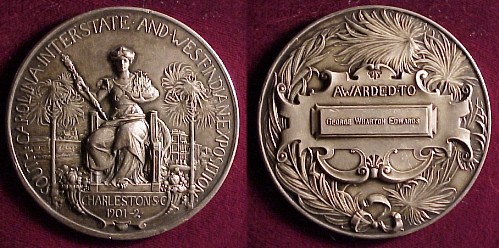
www.expomedals.com

